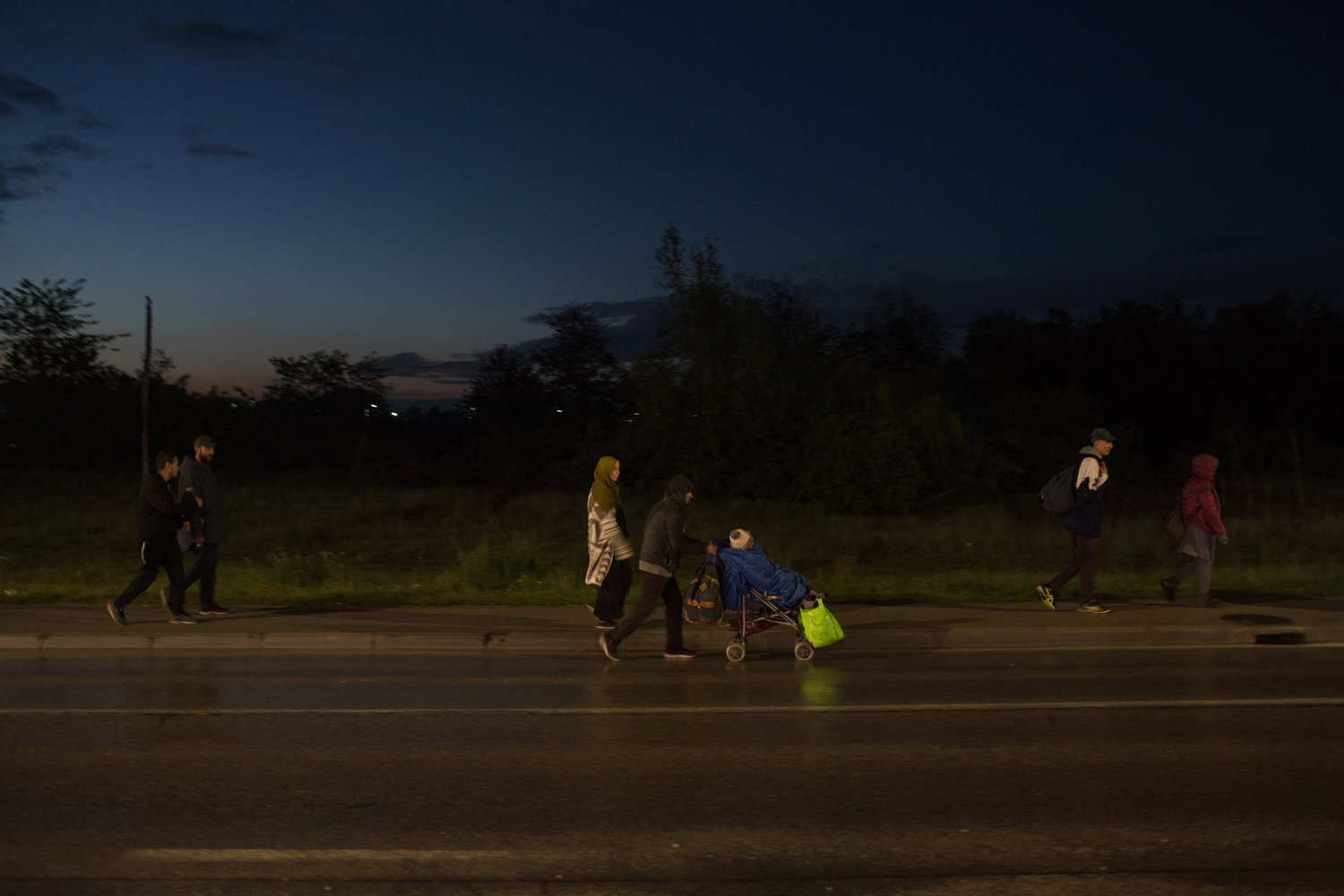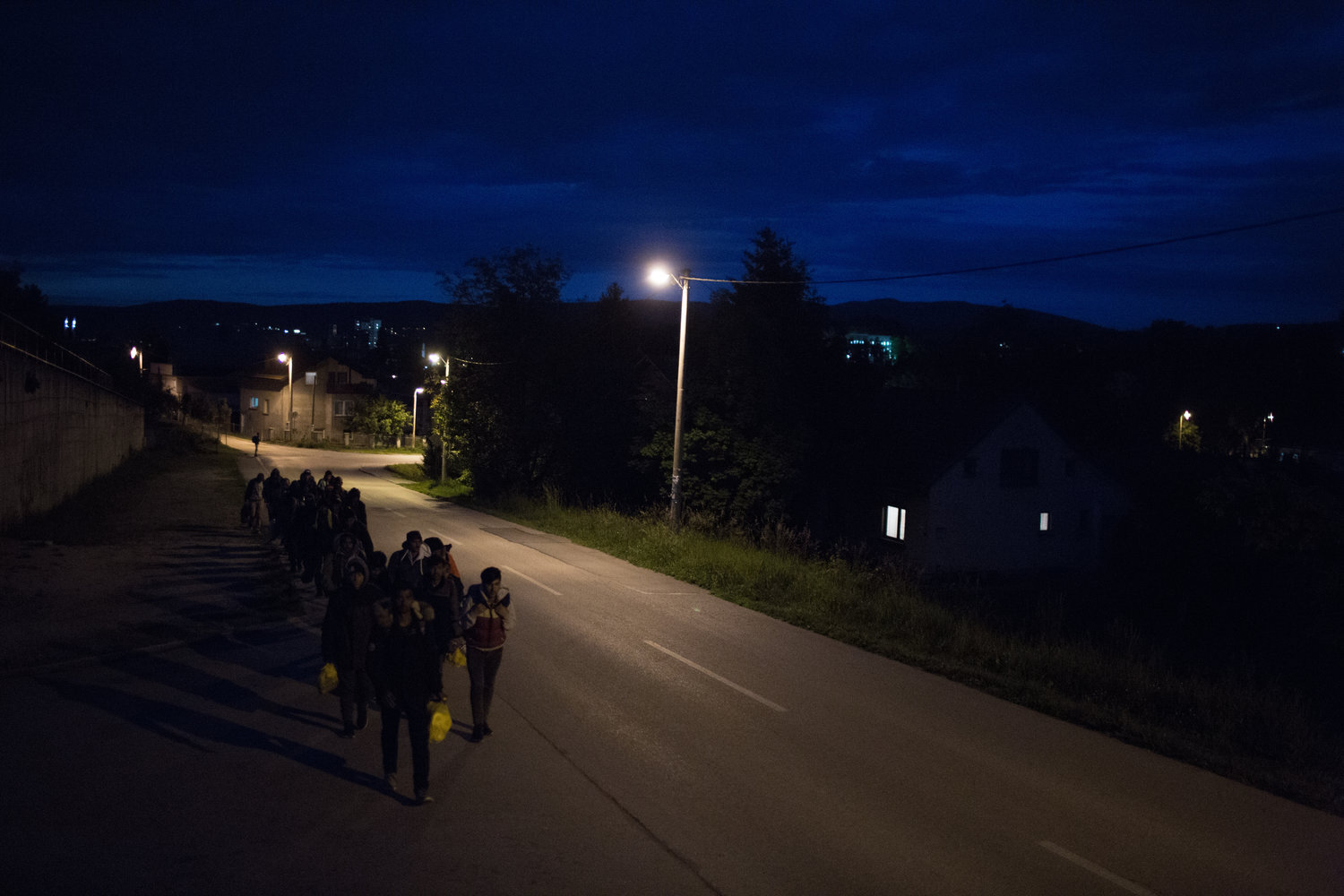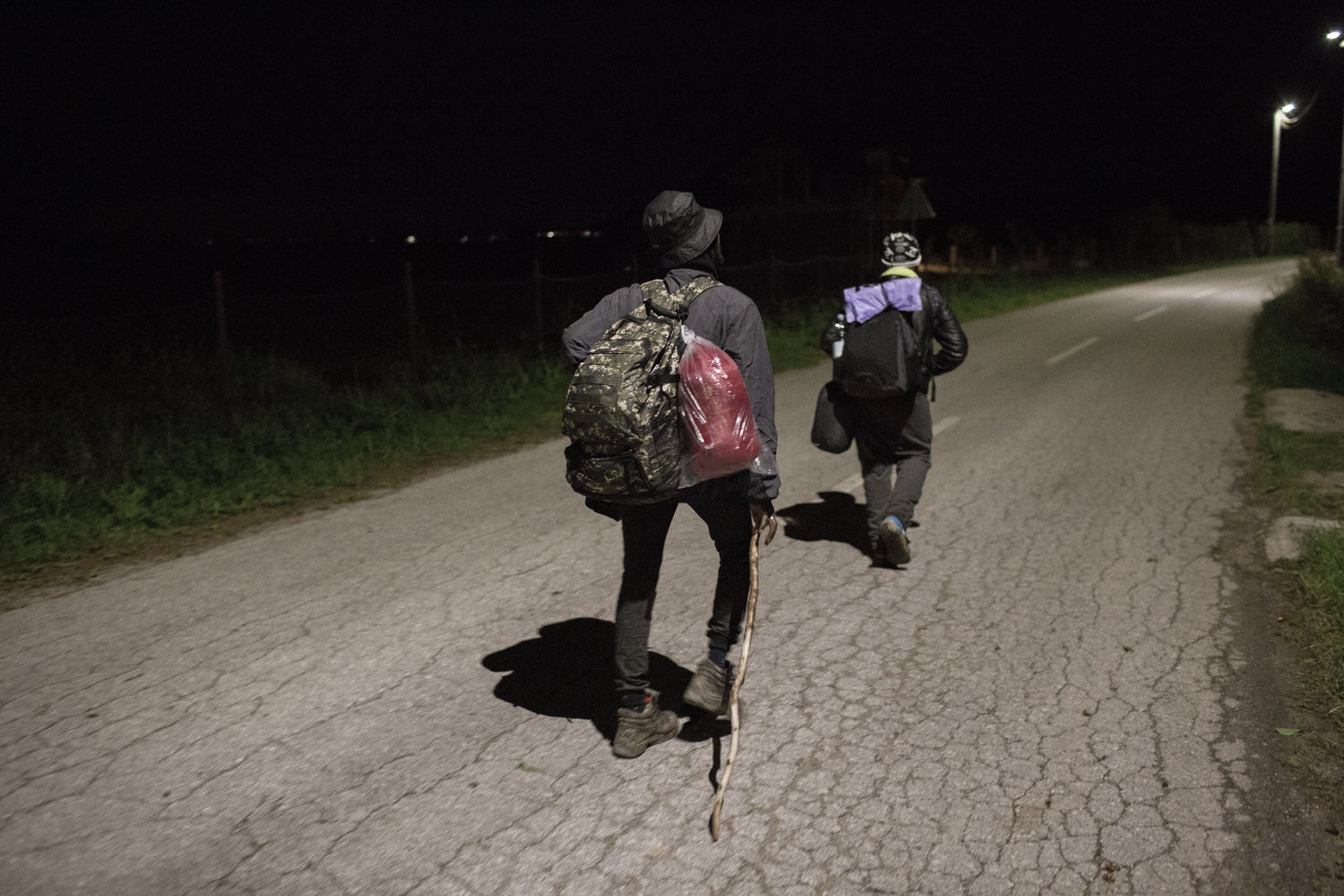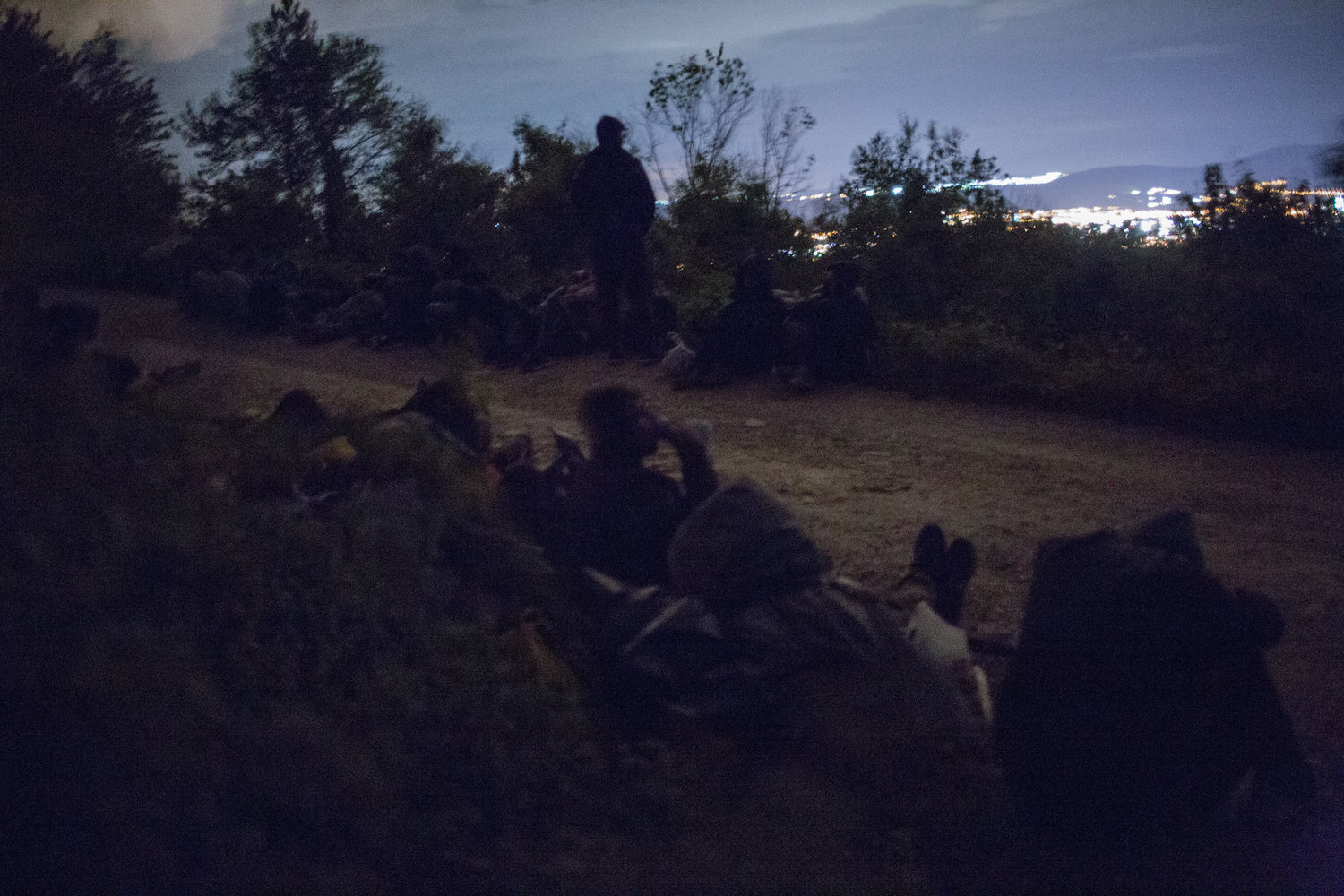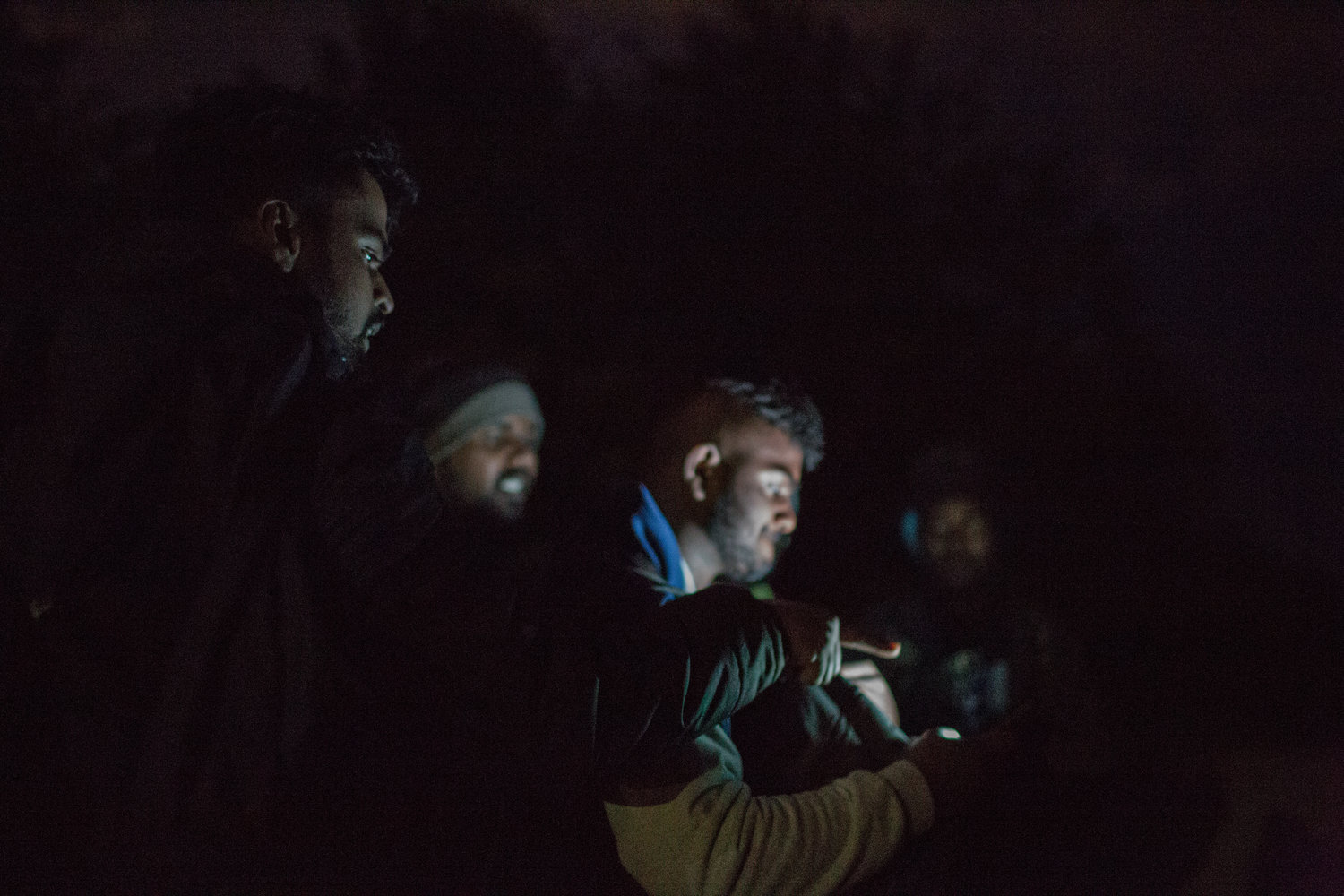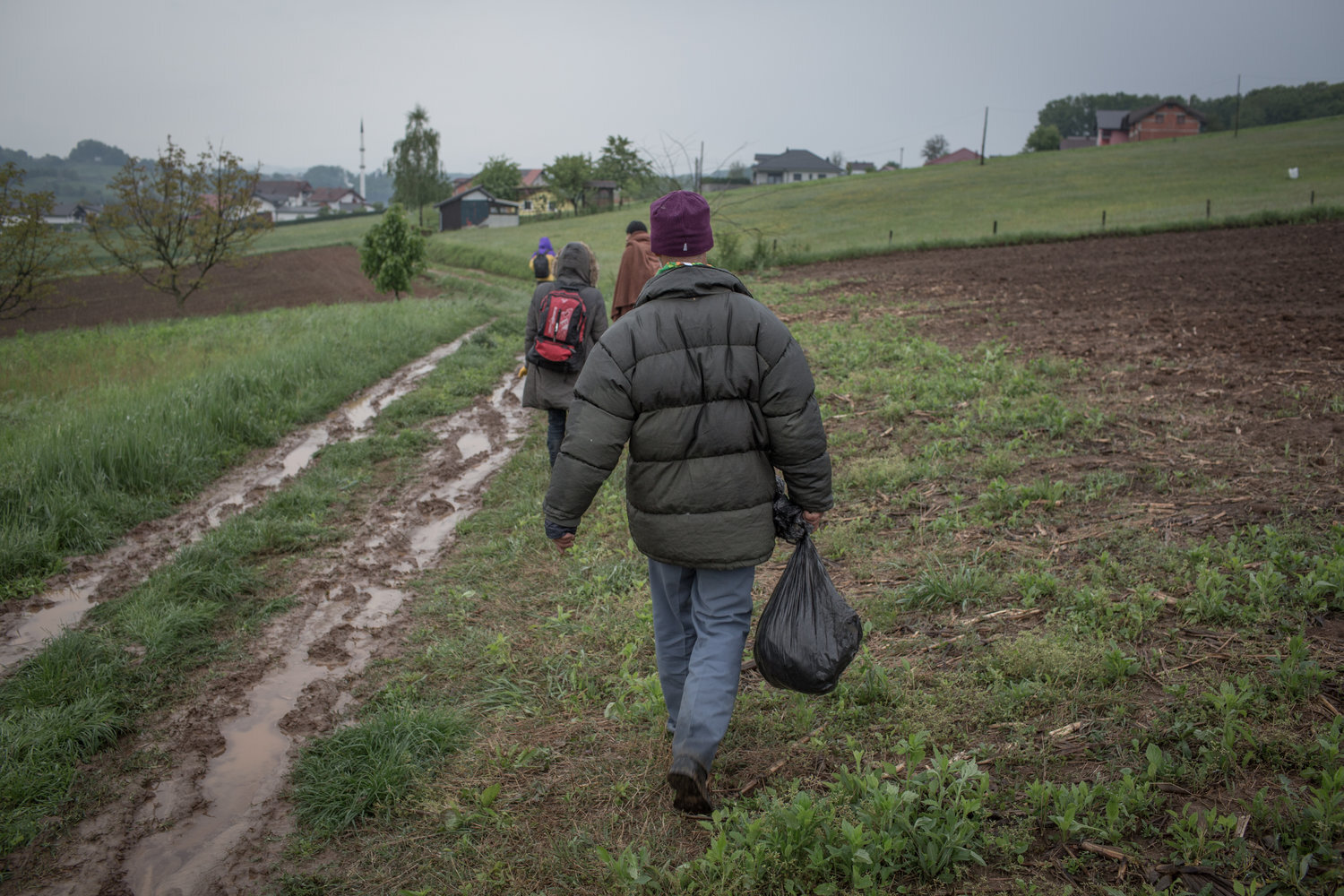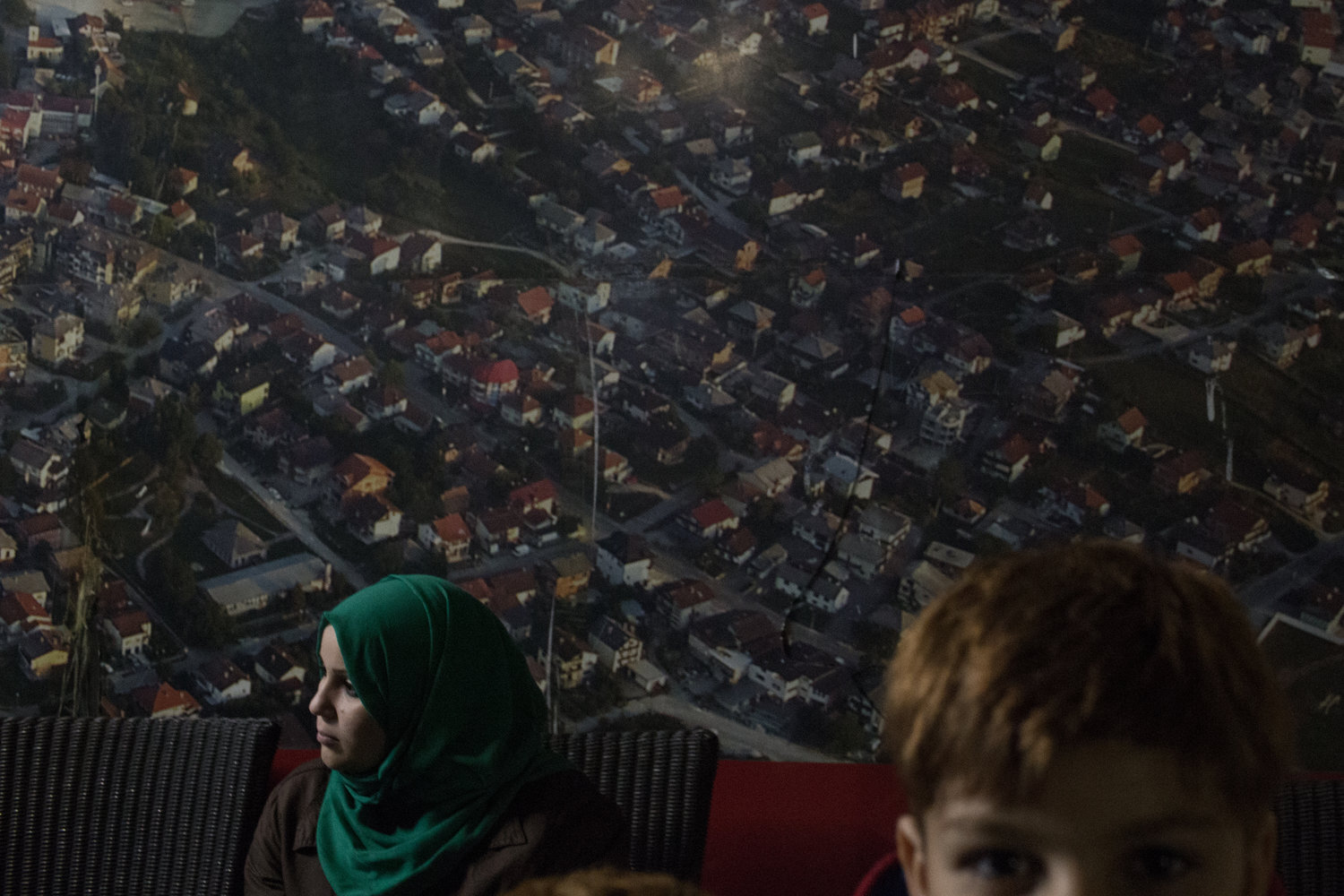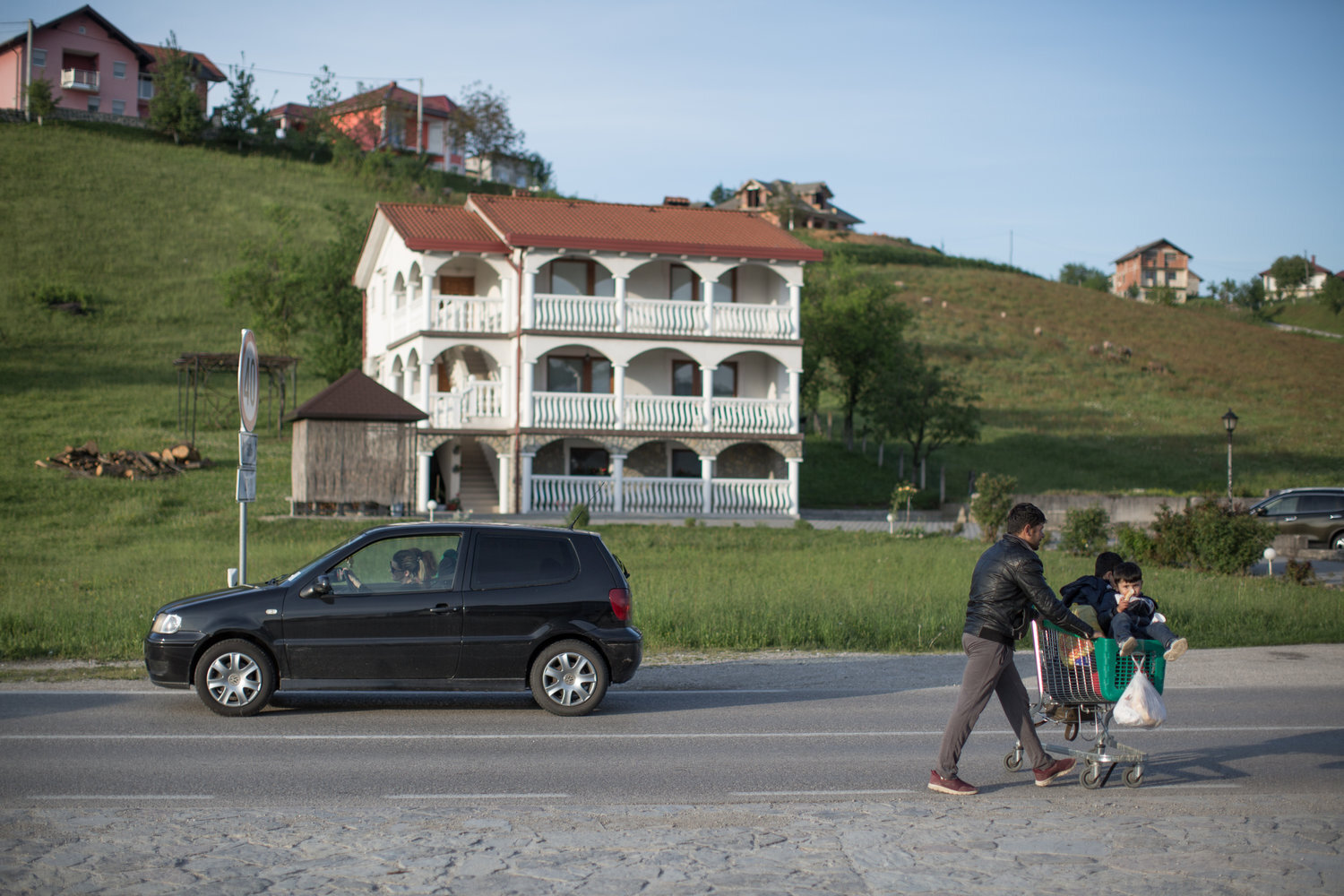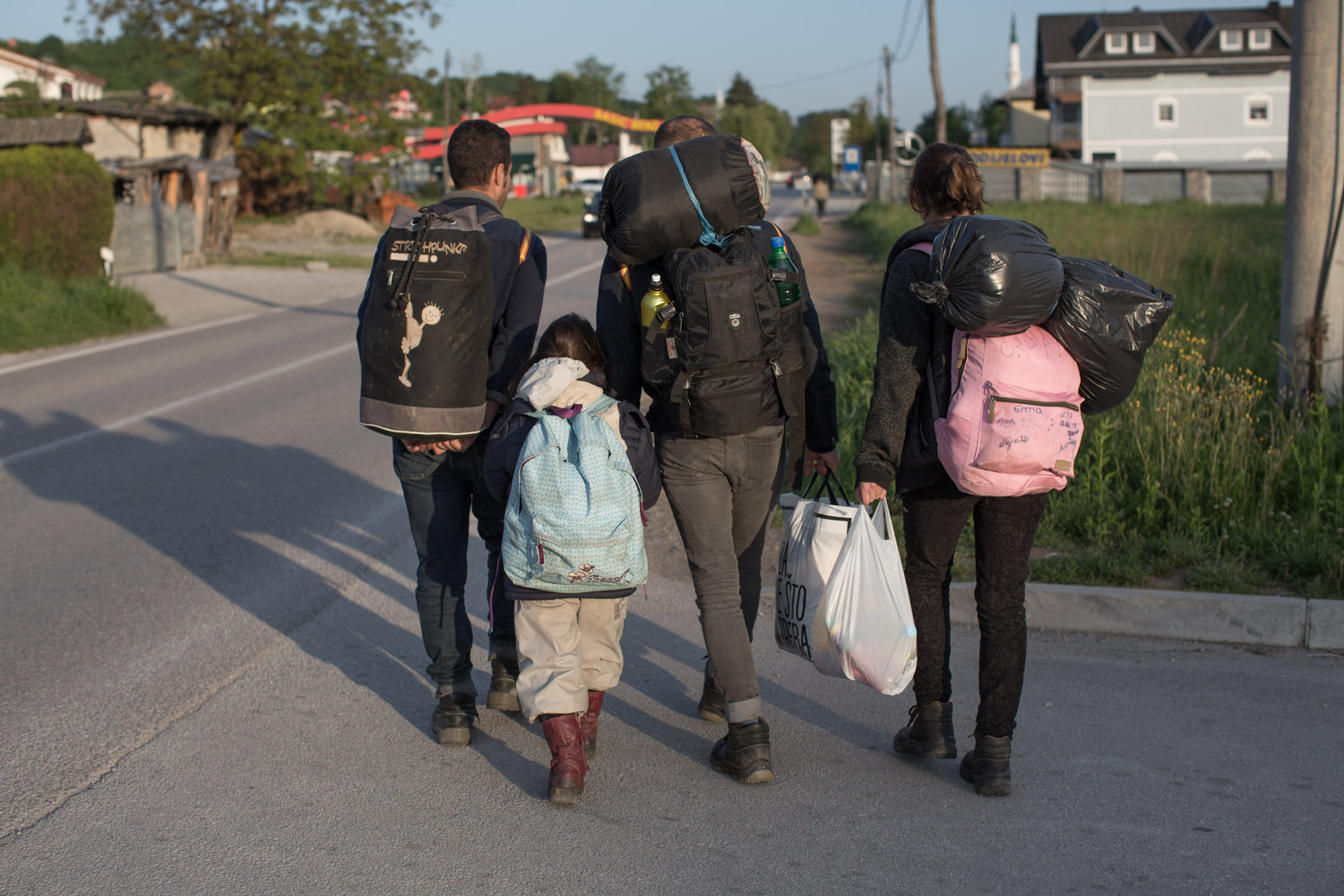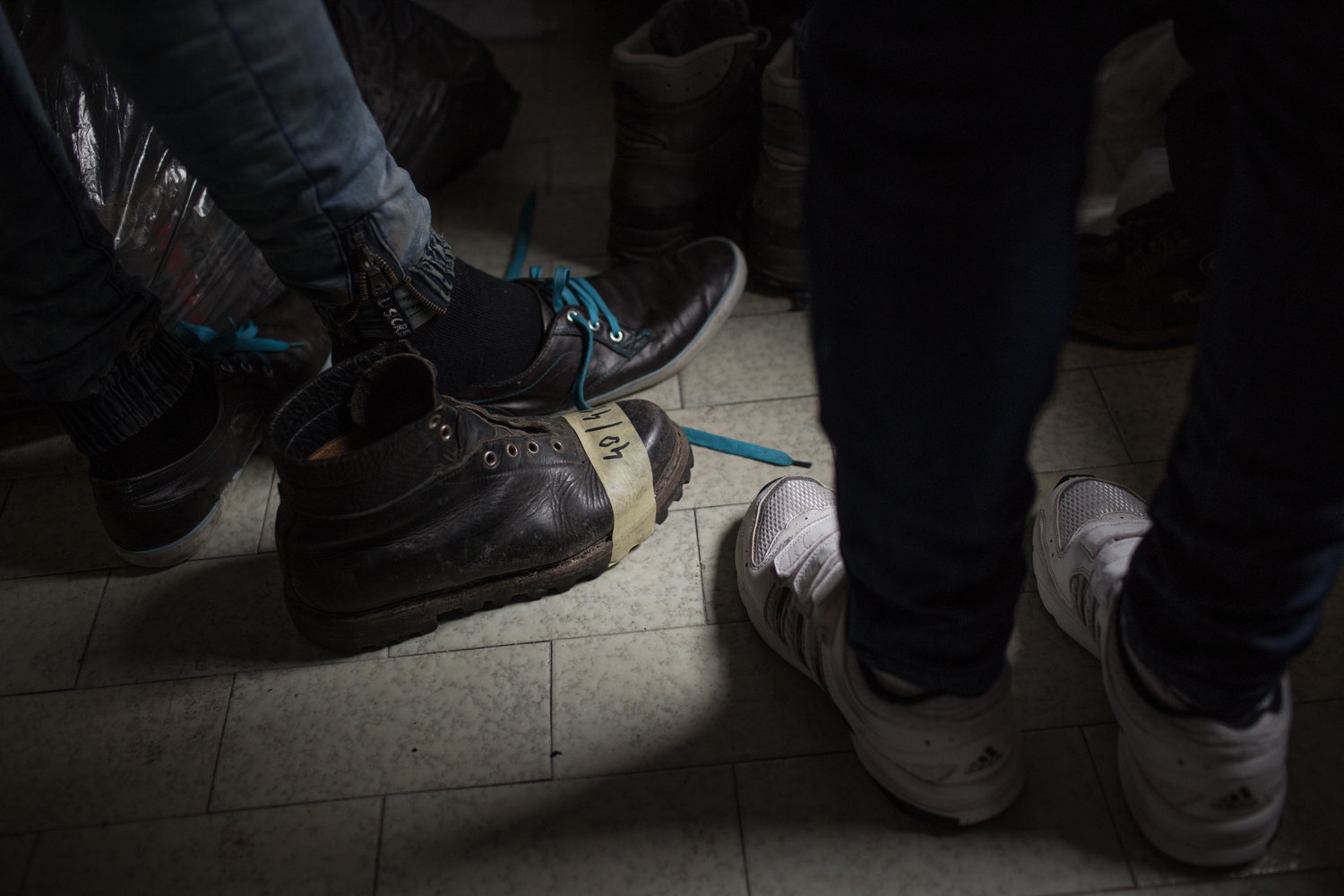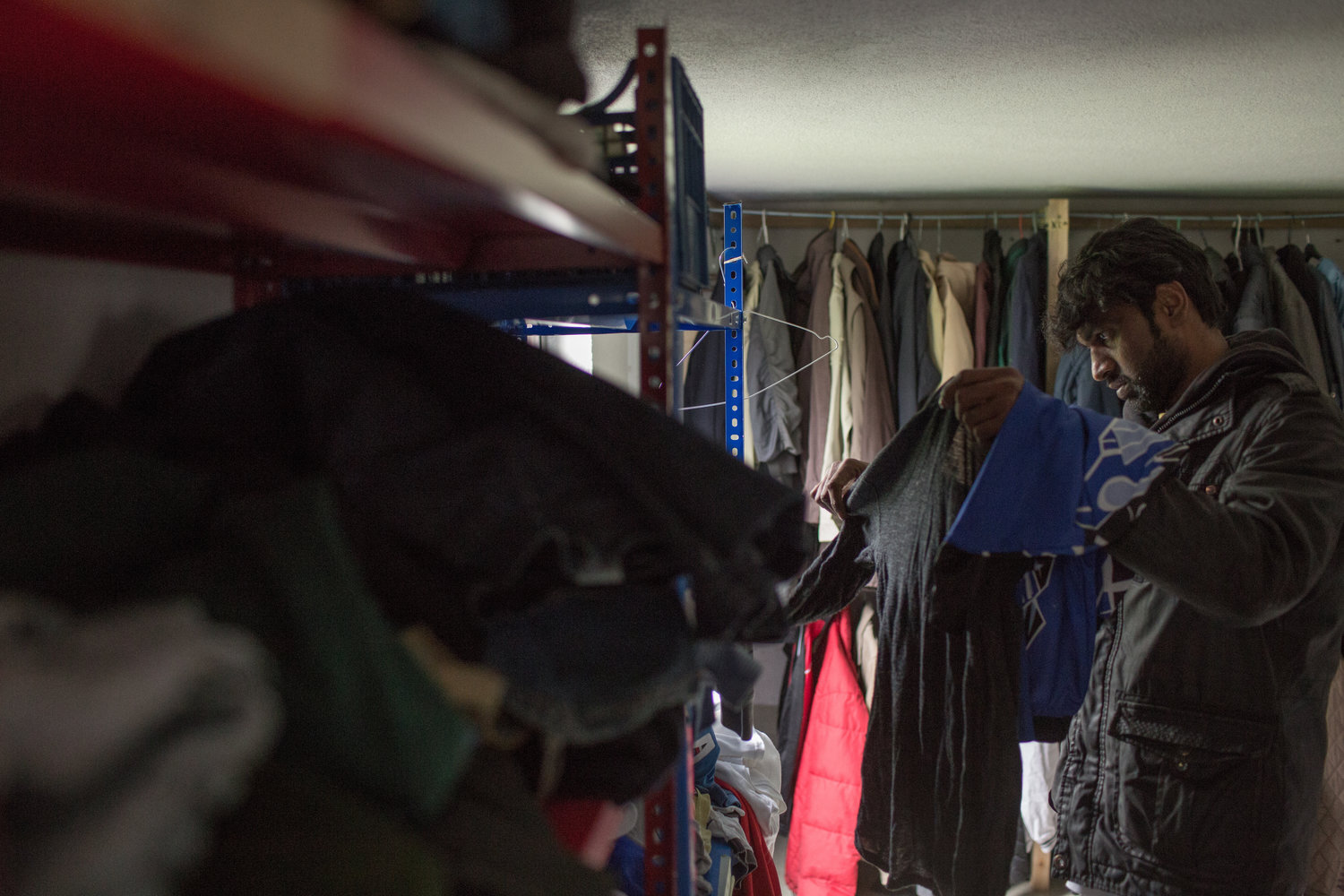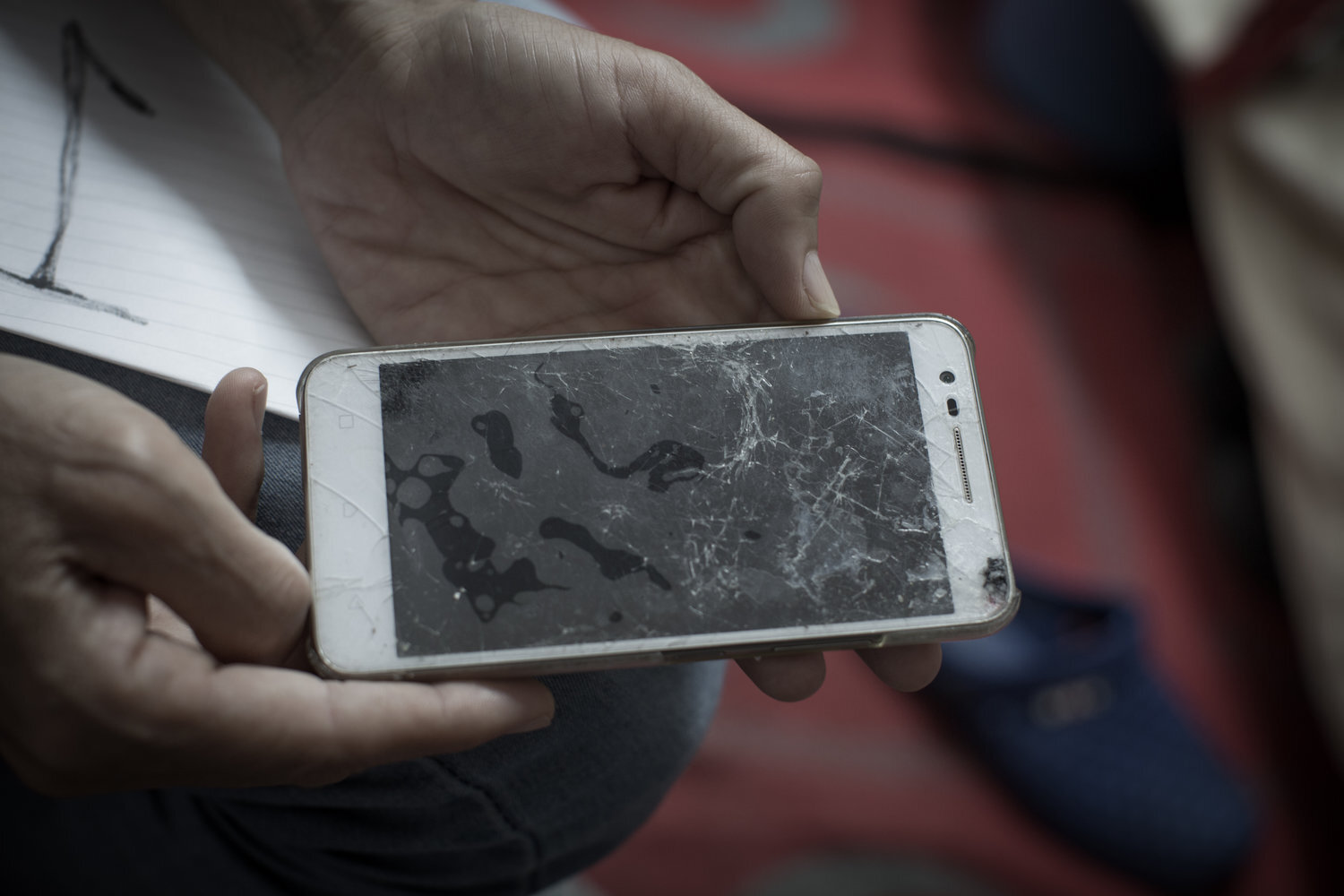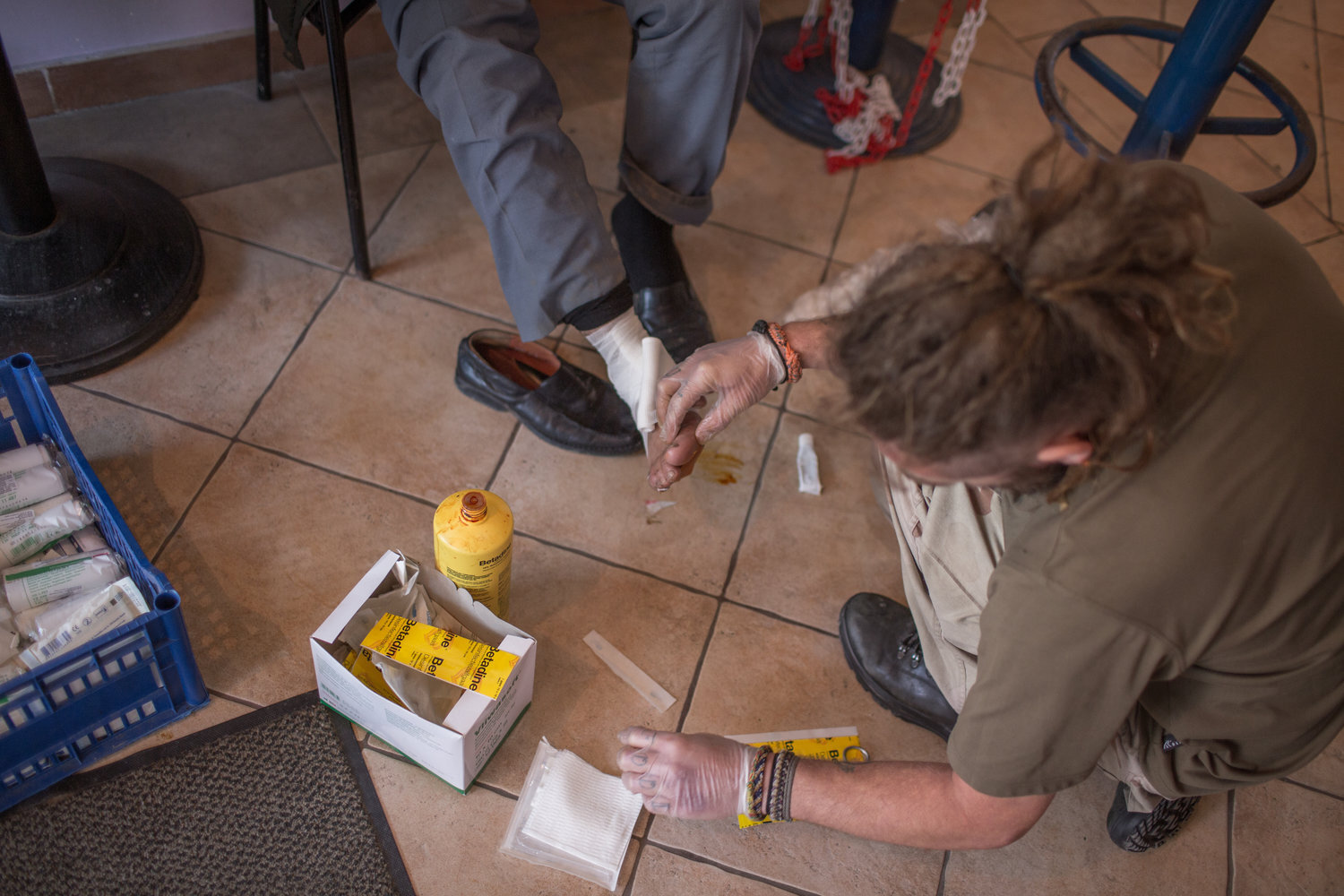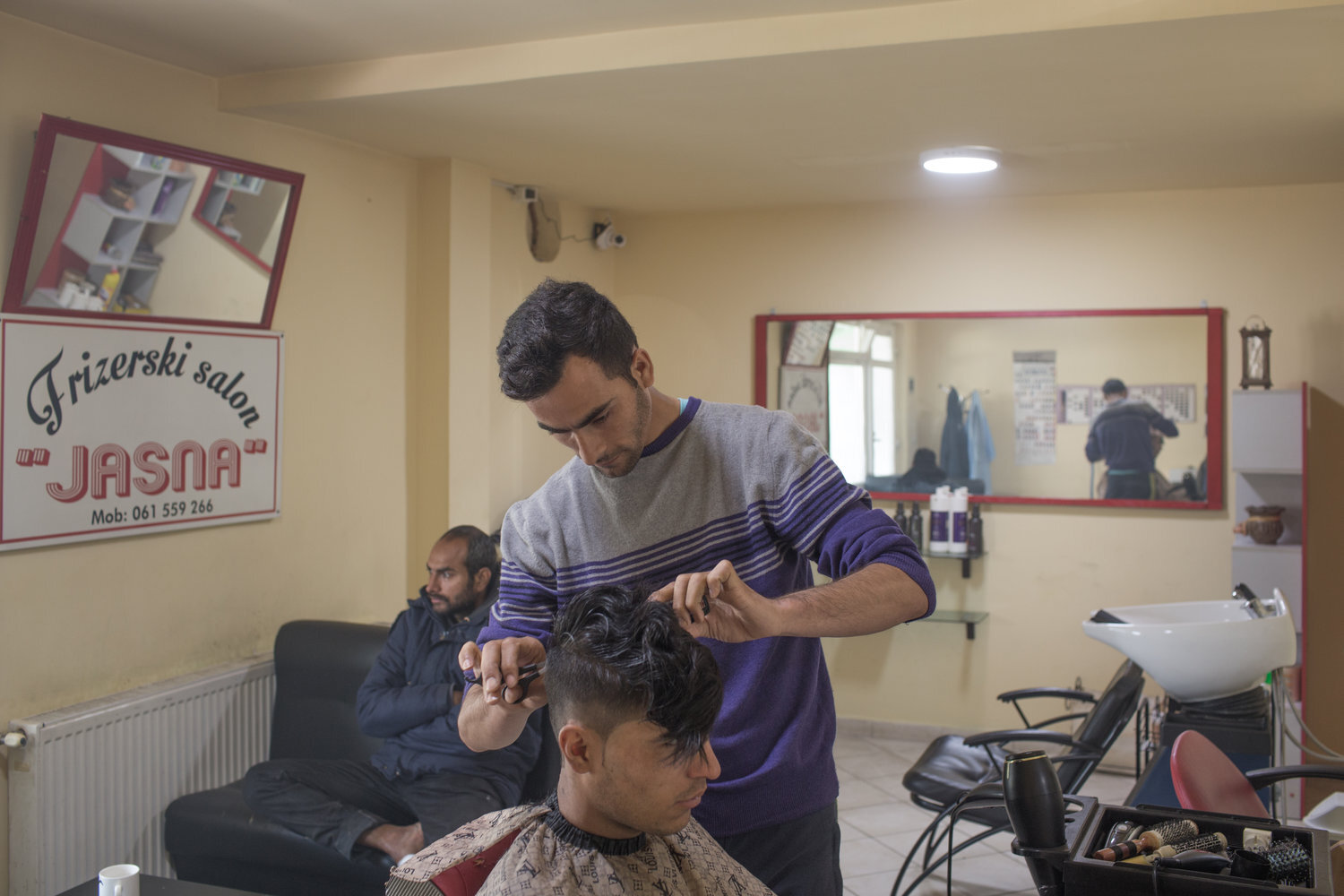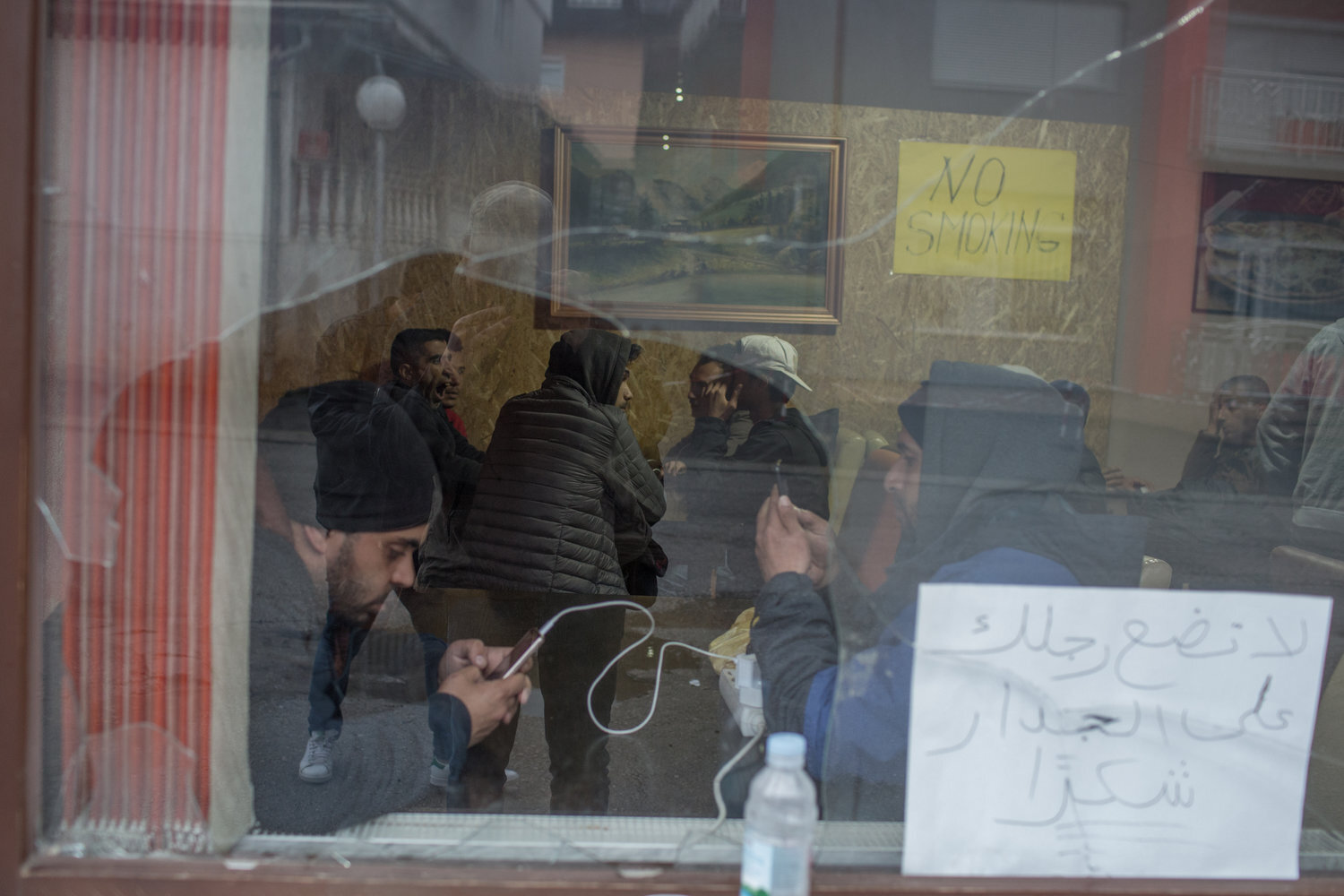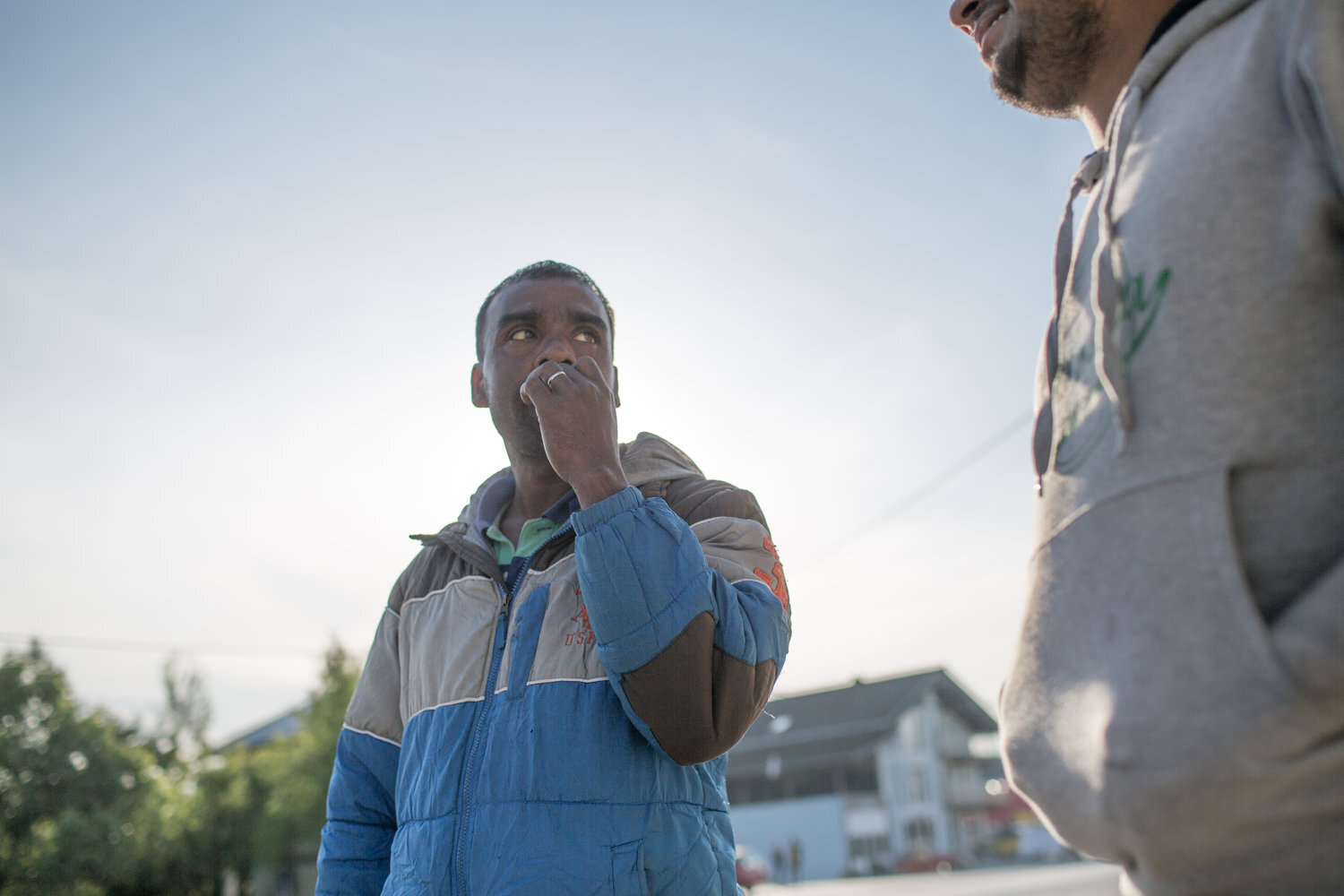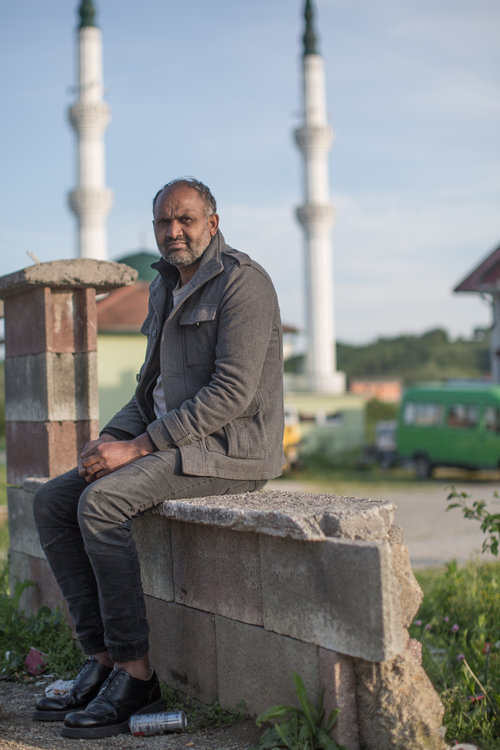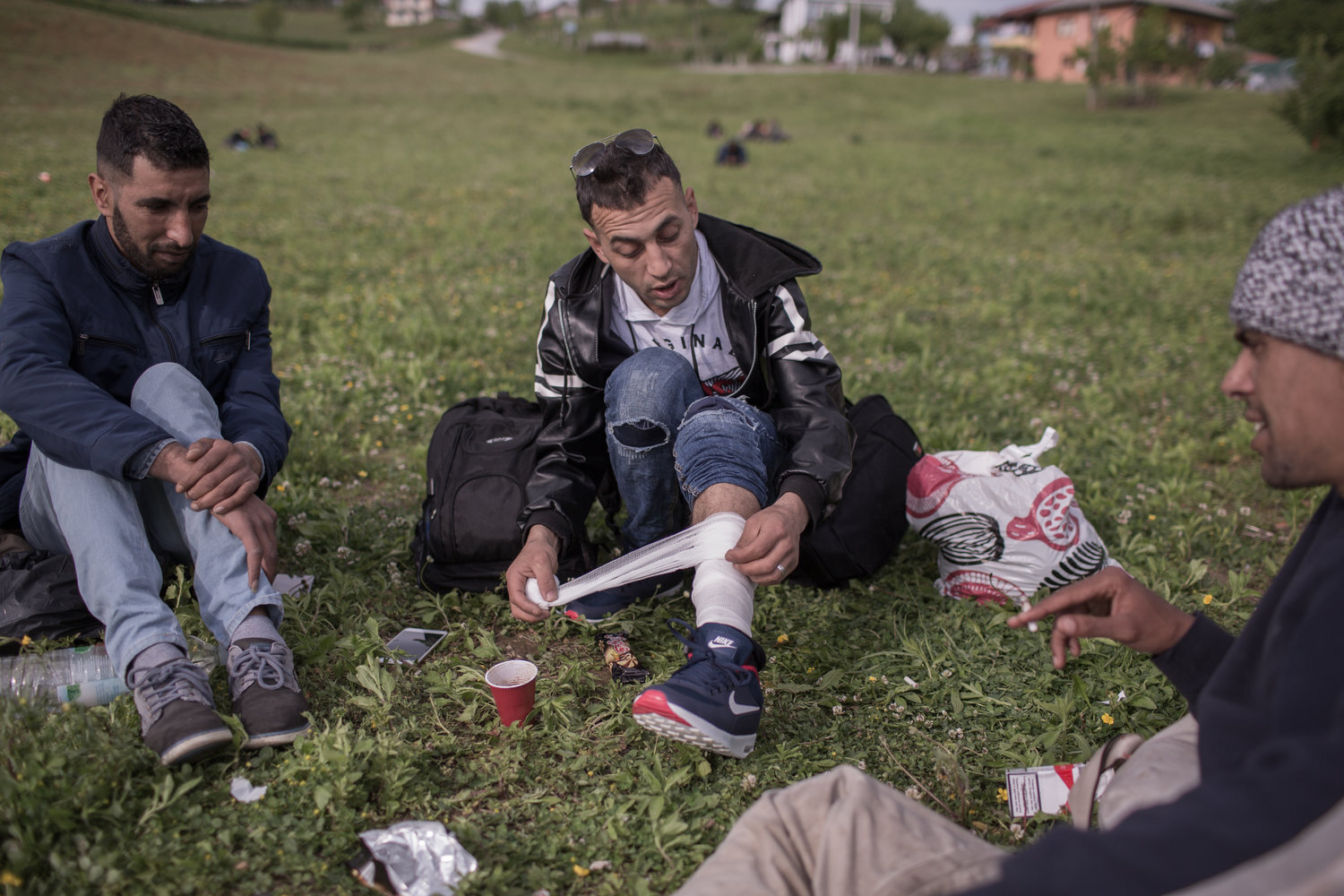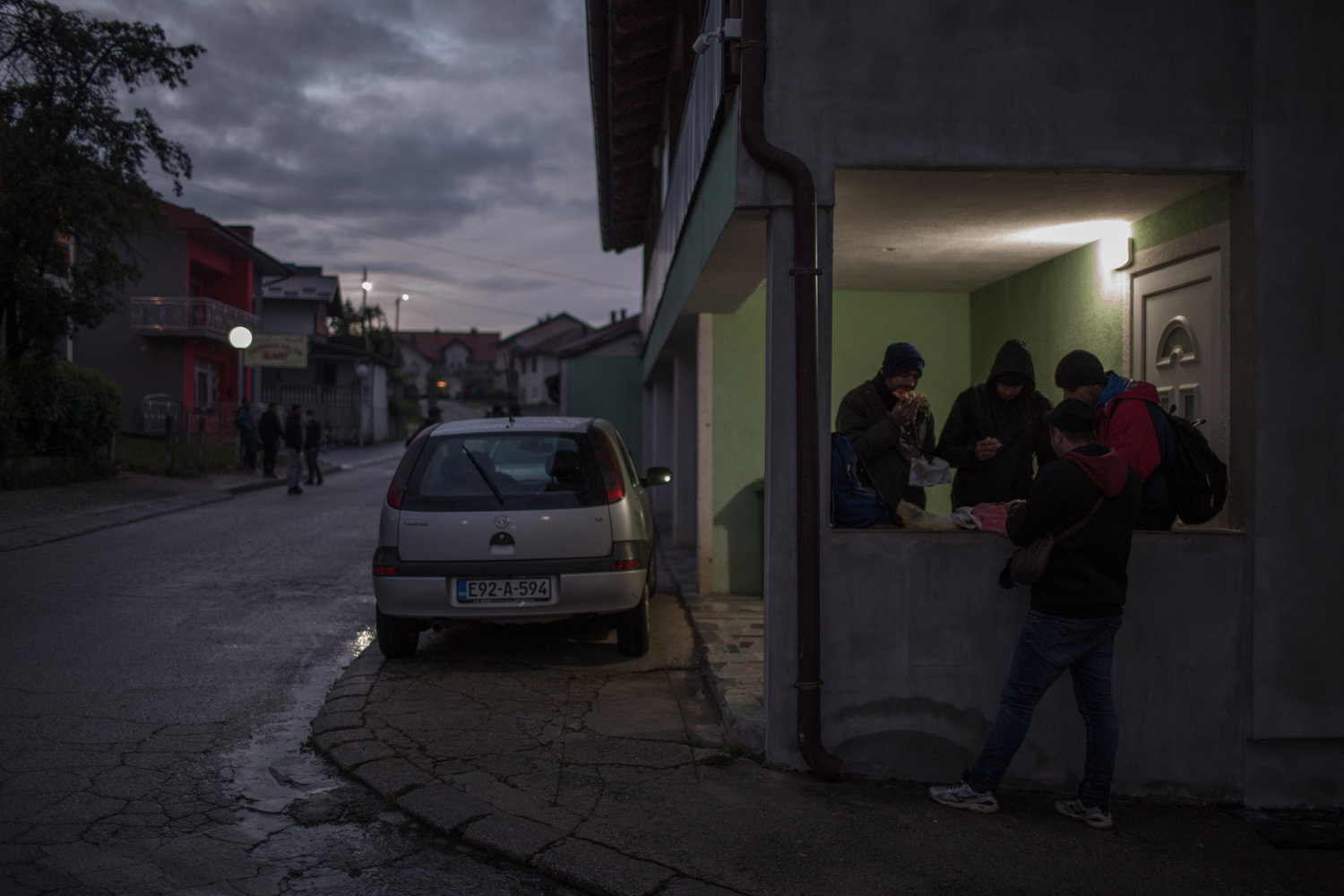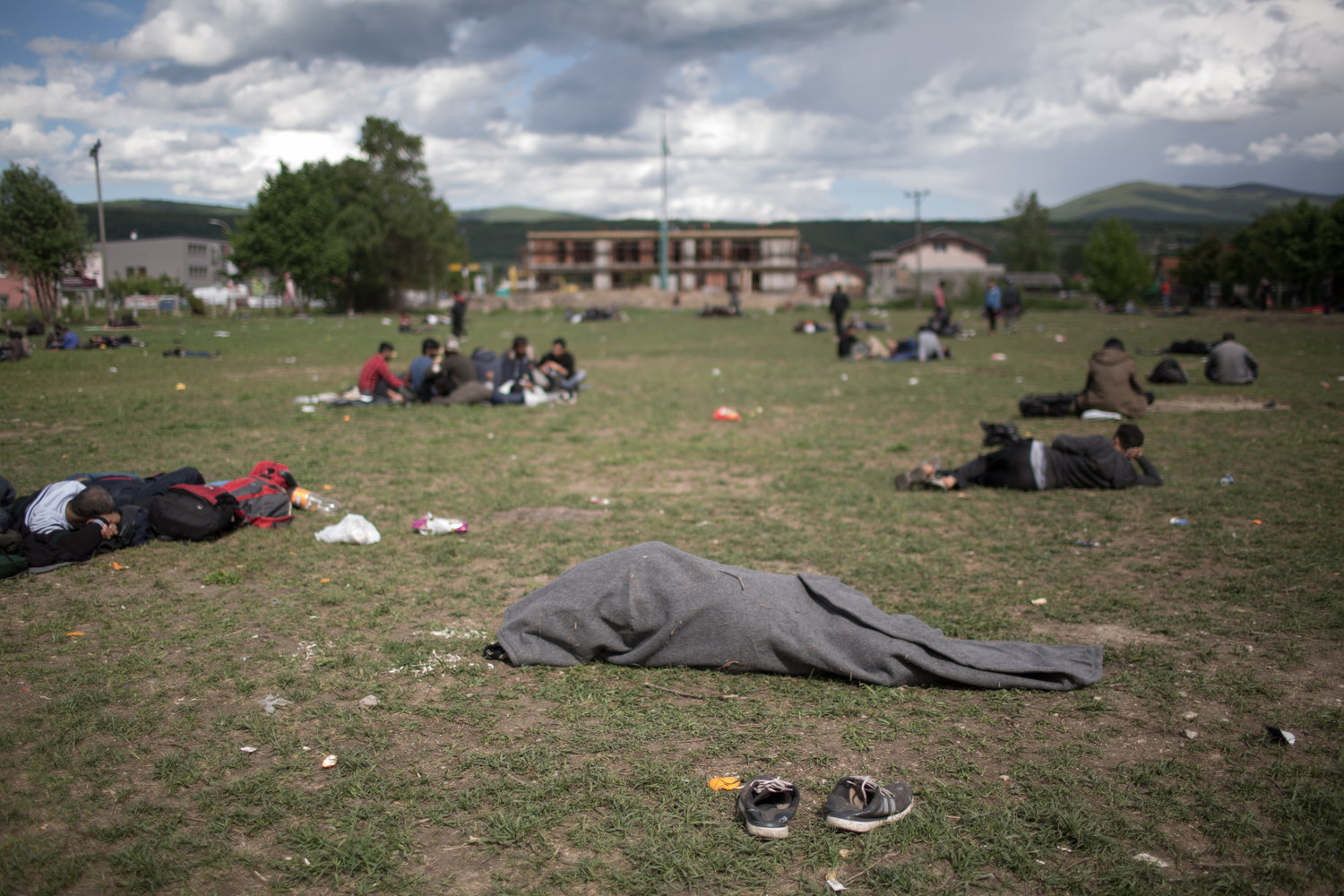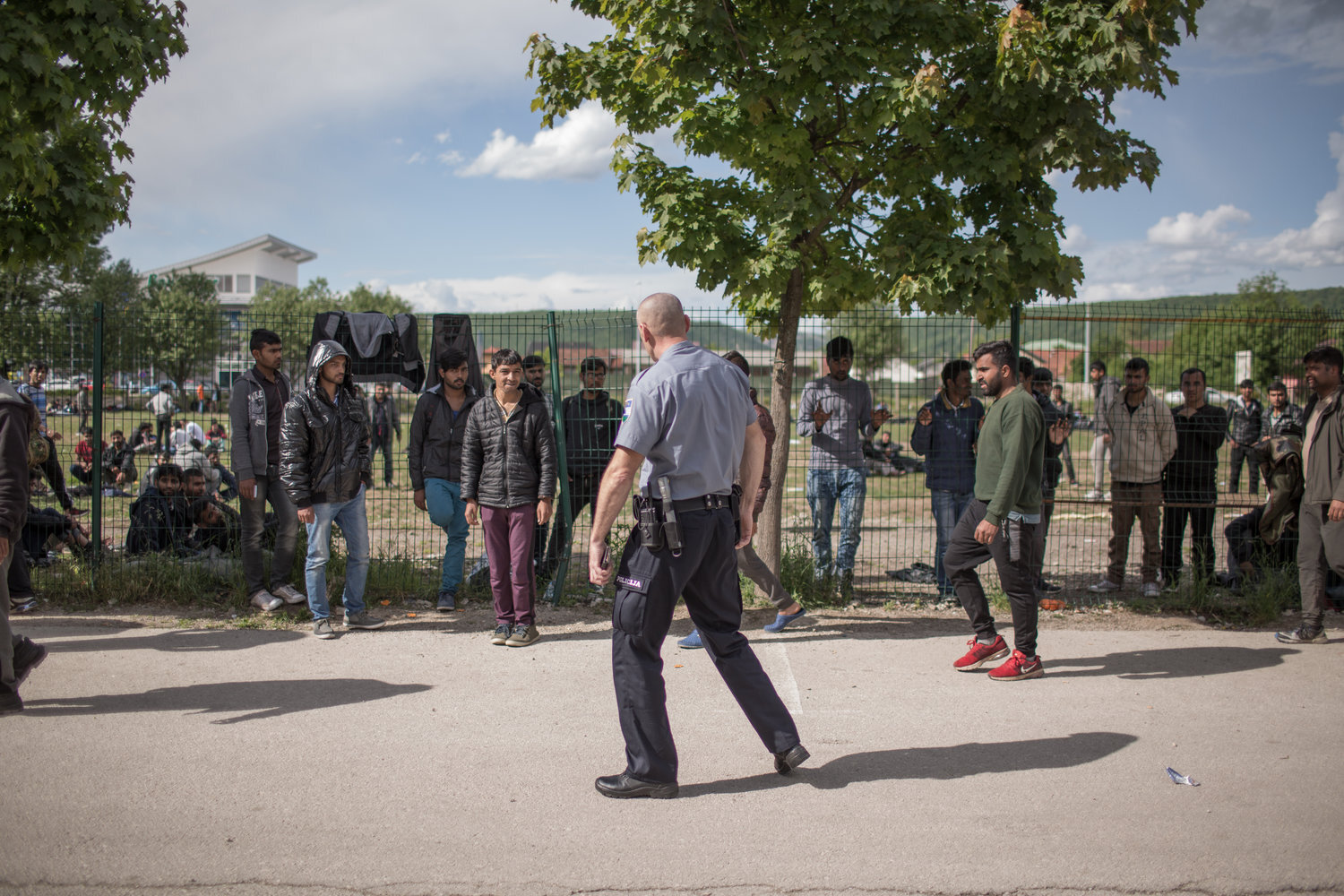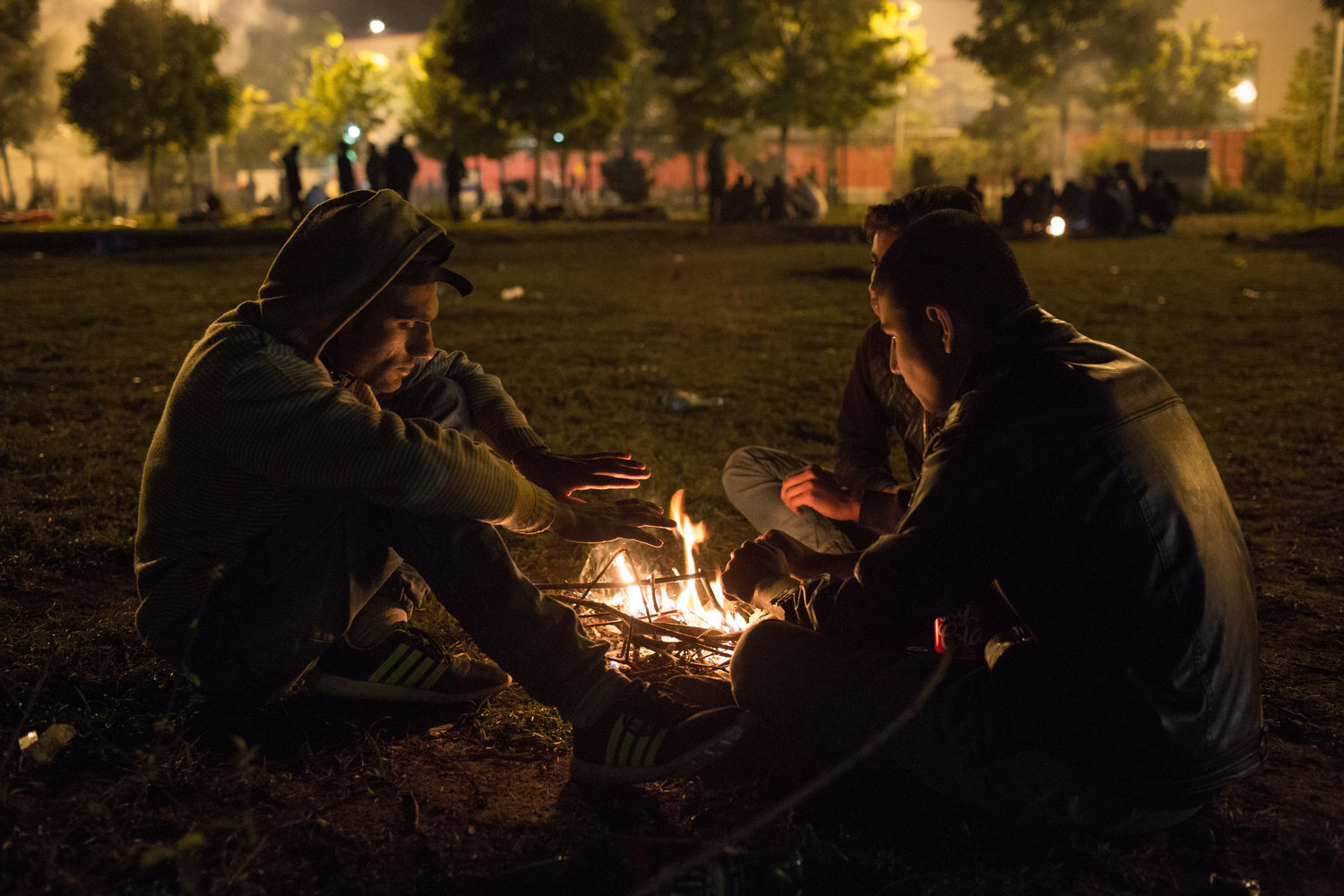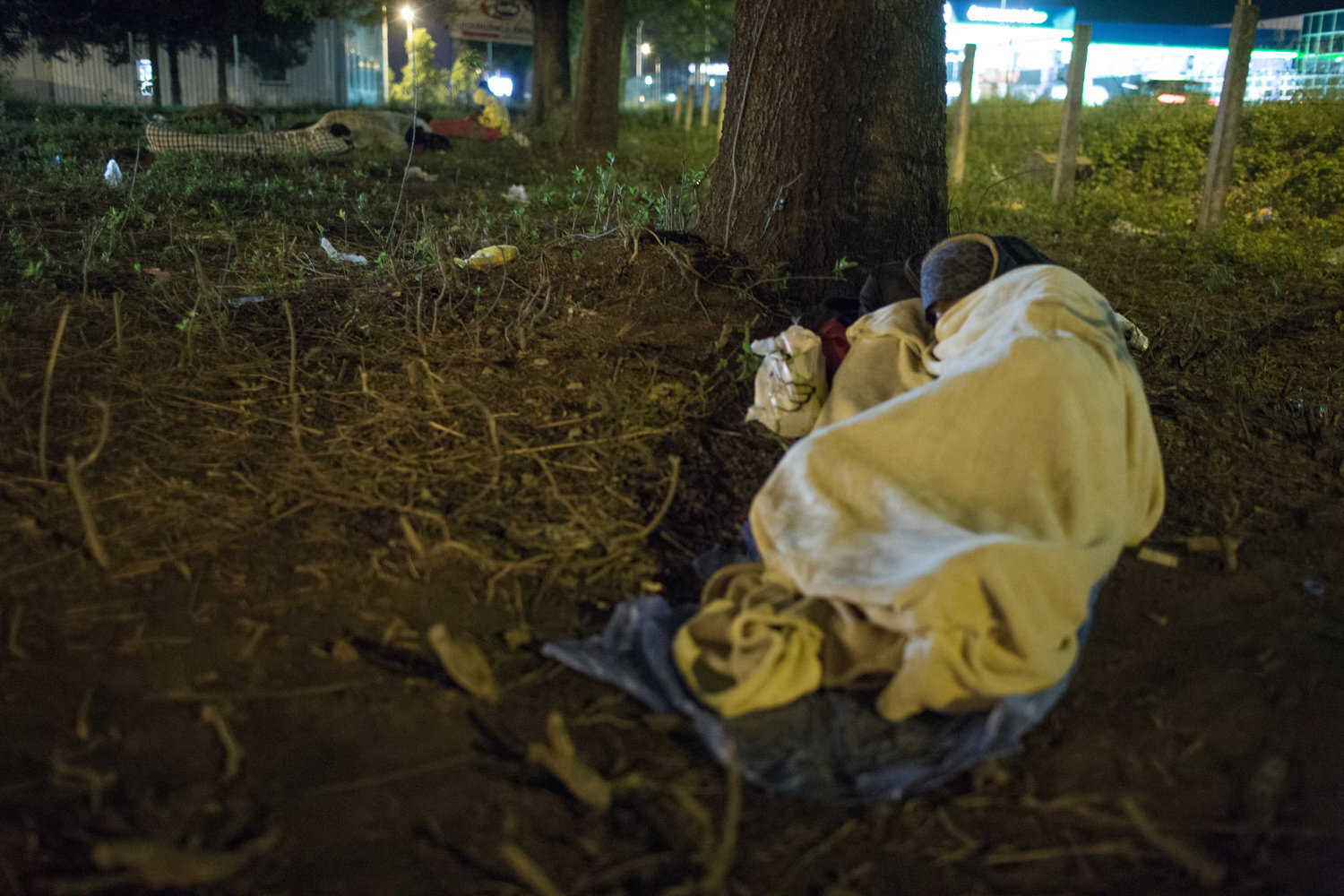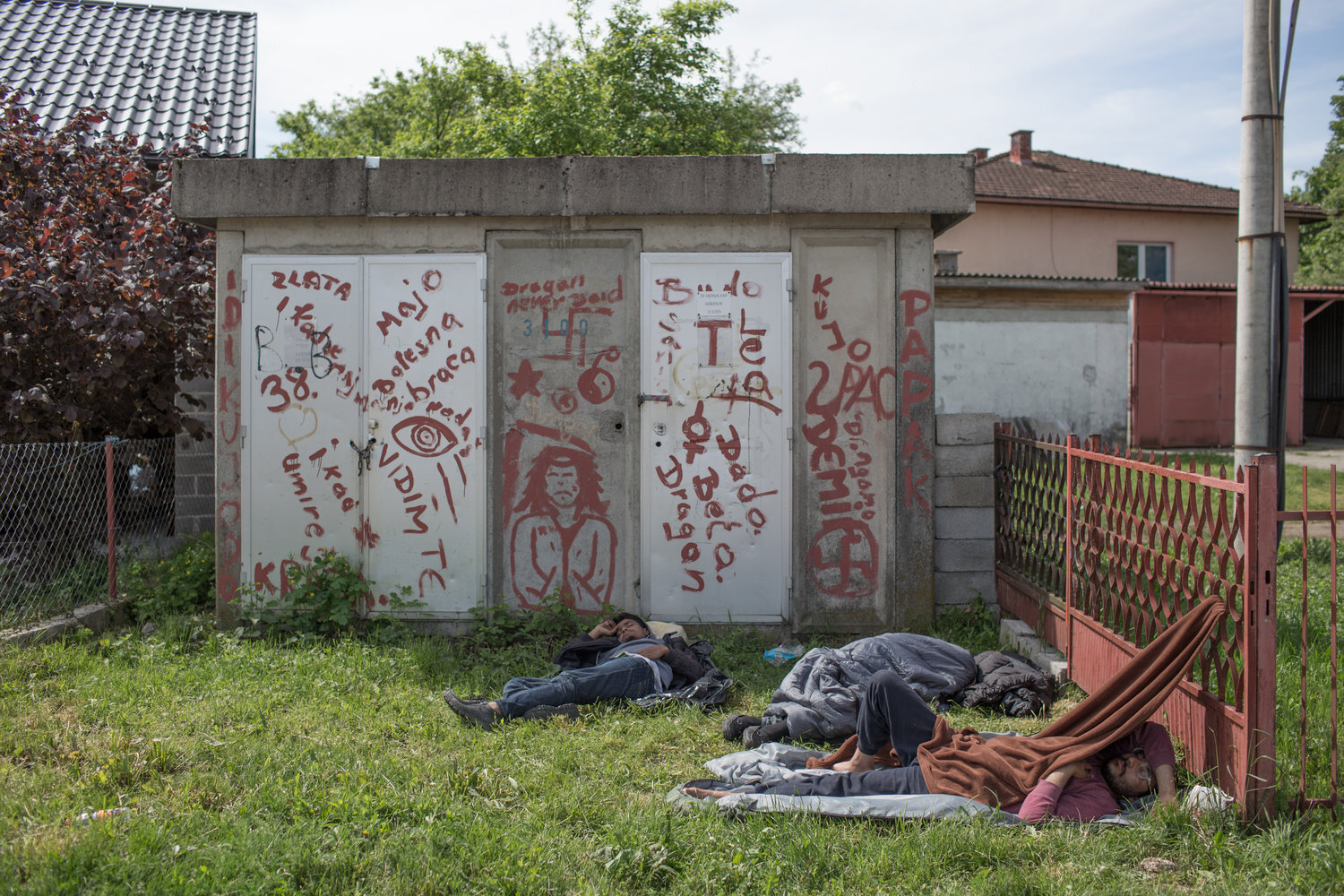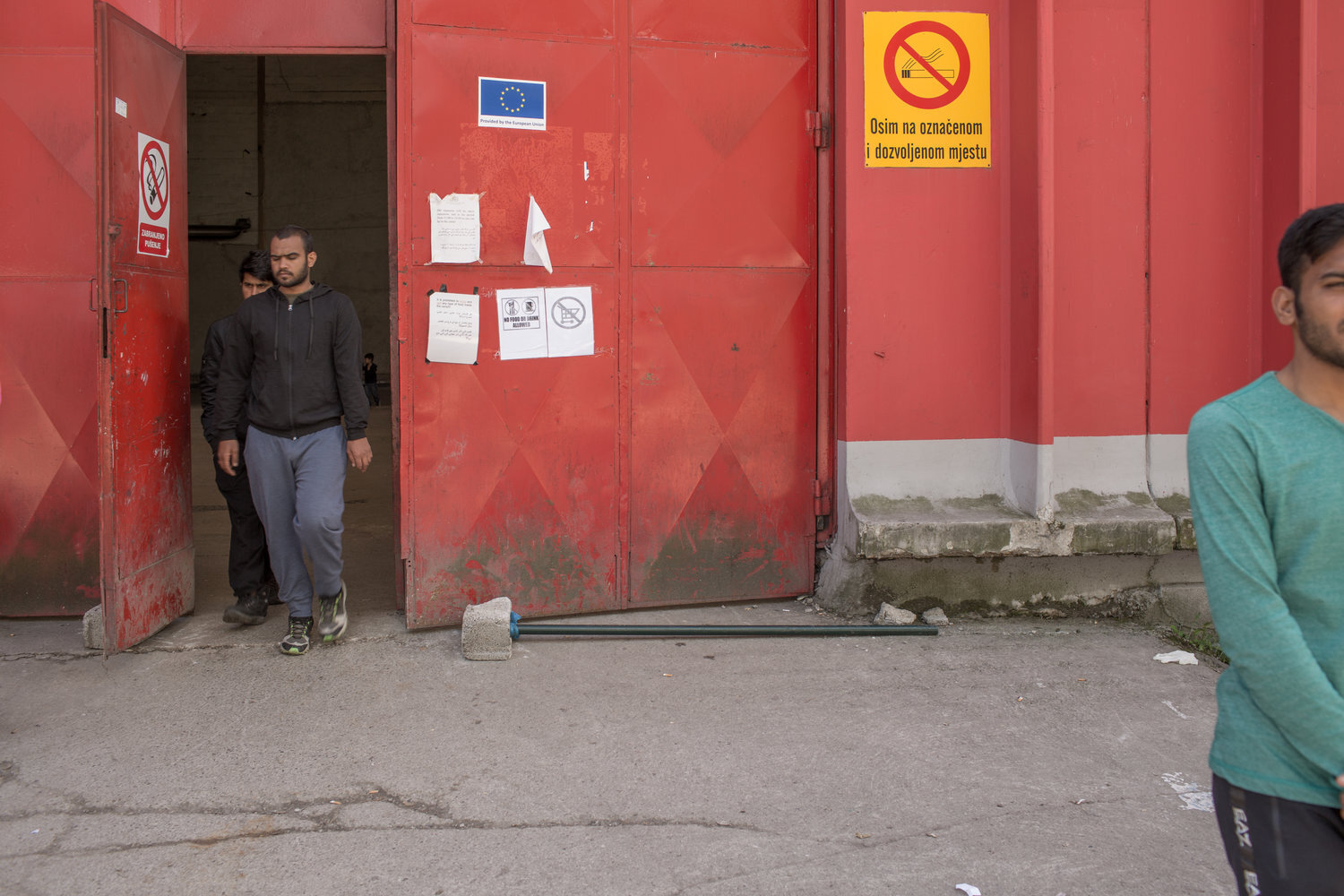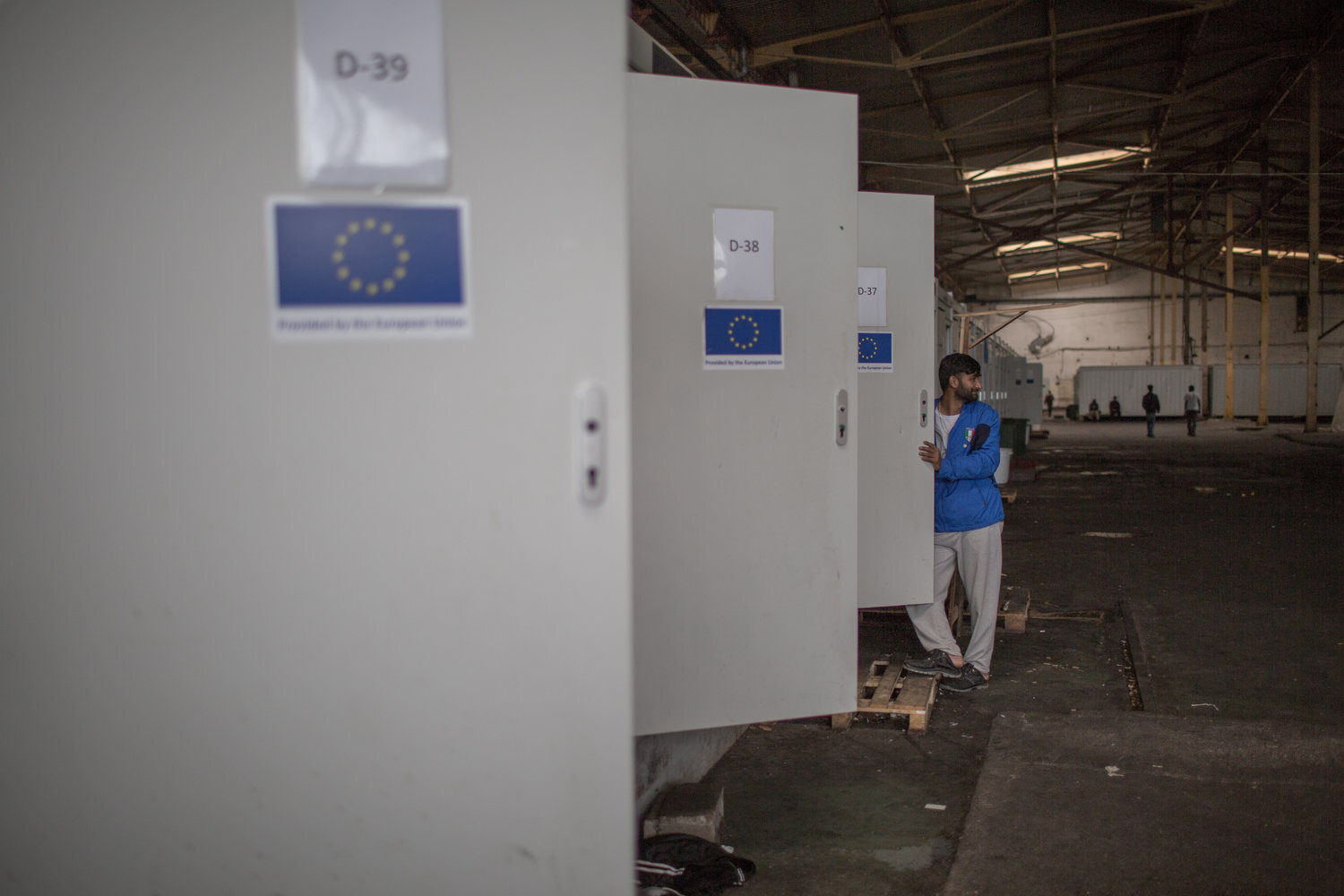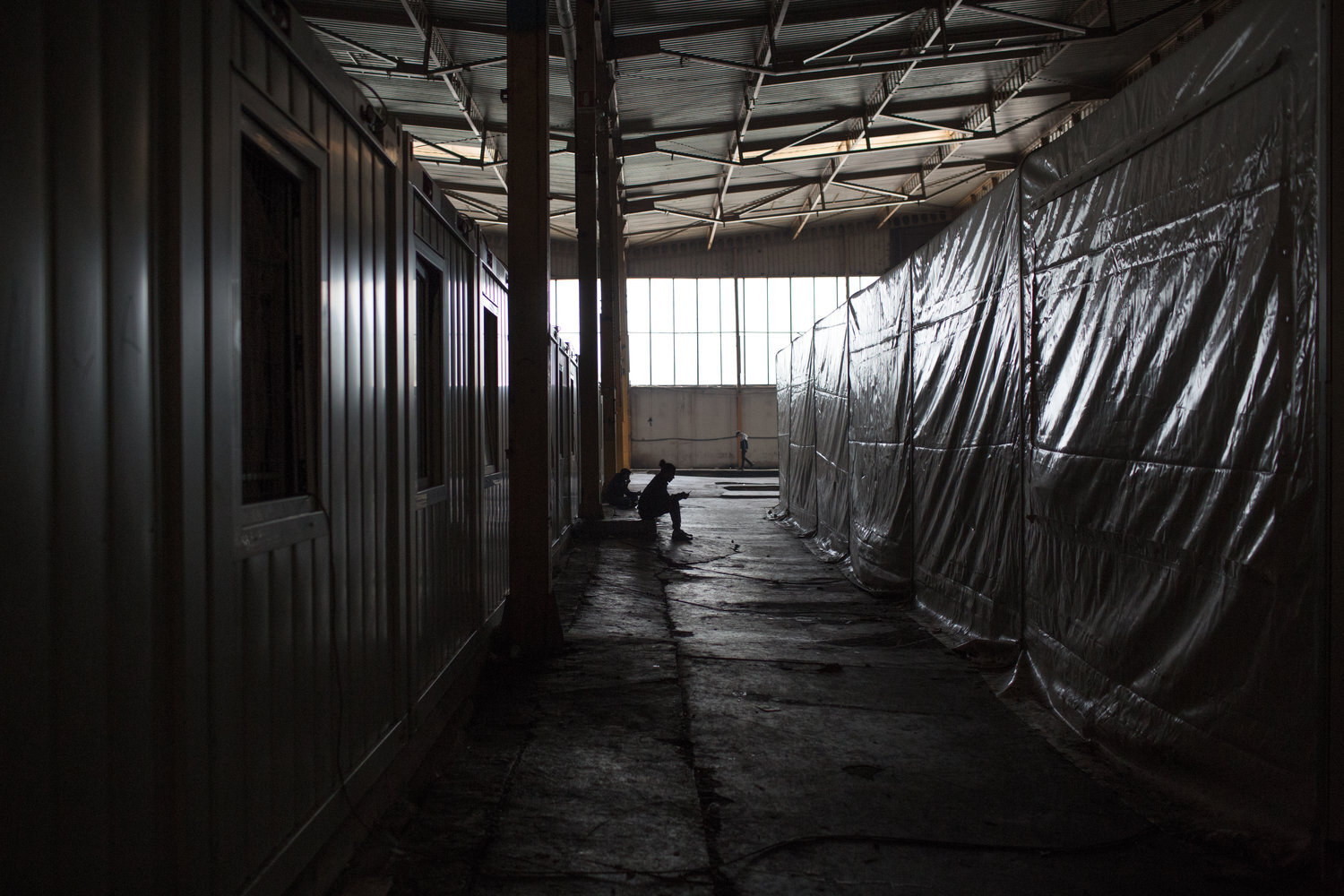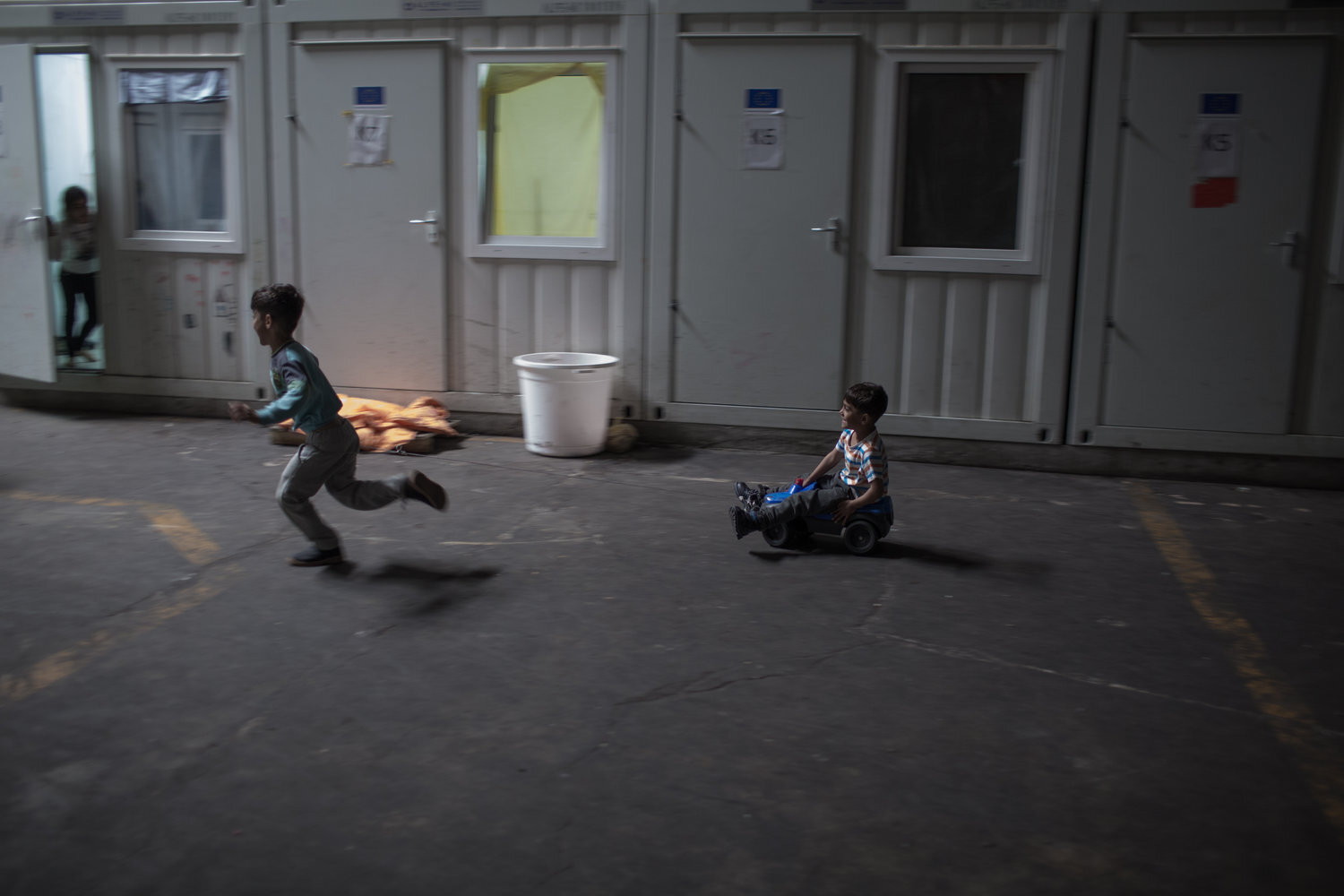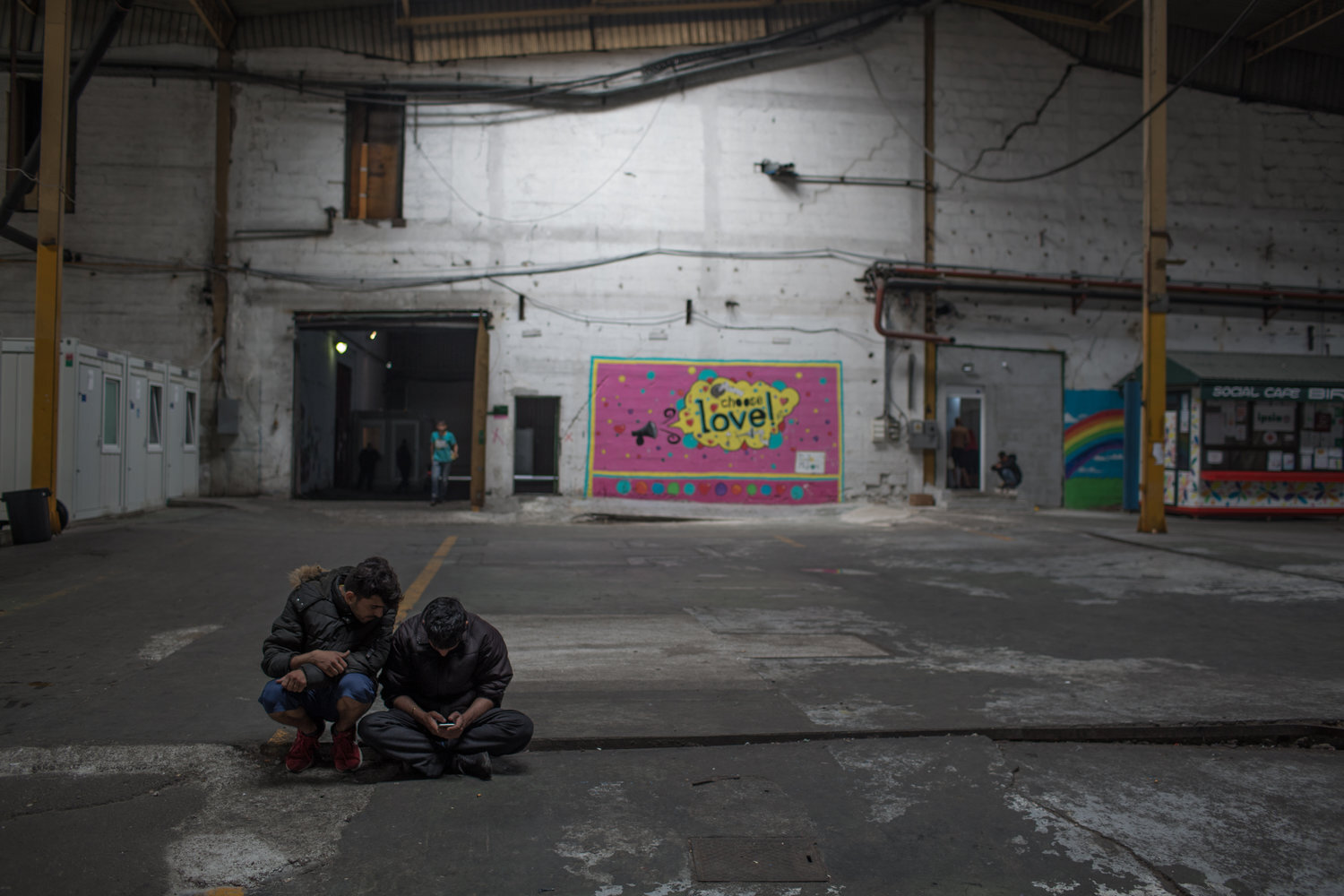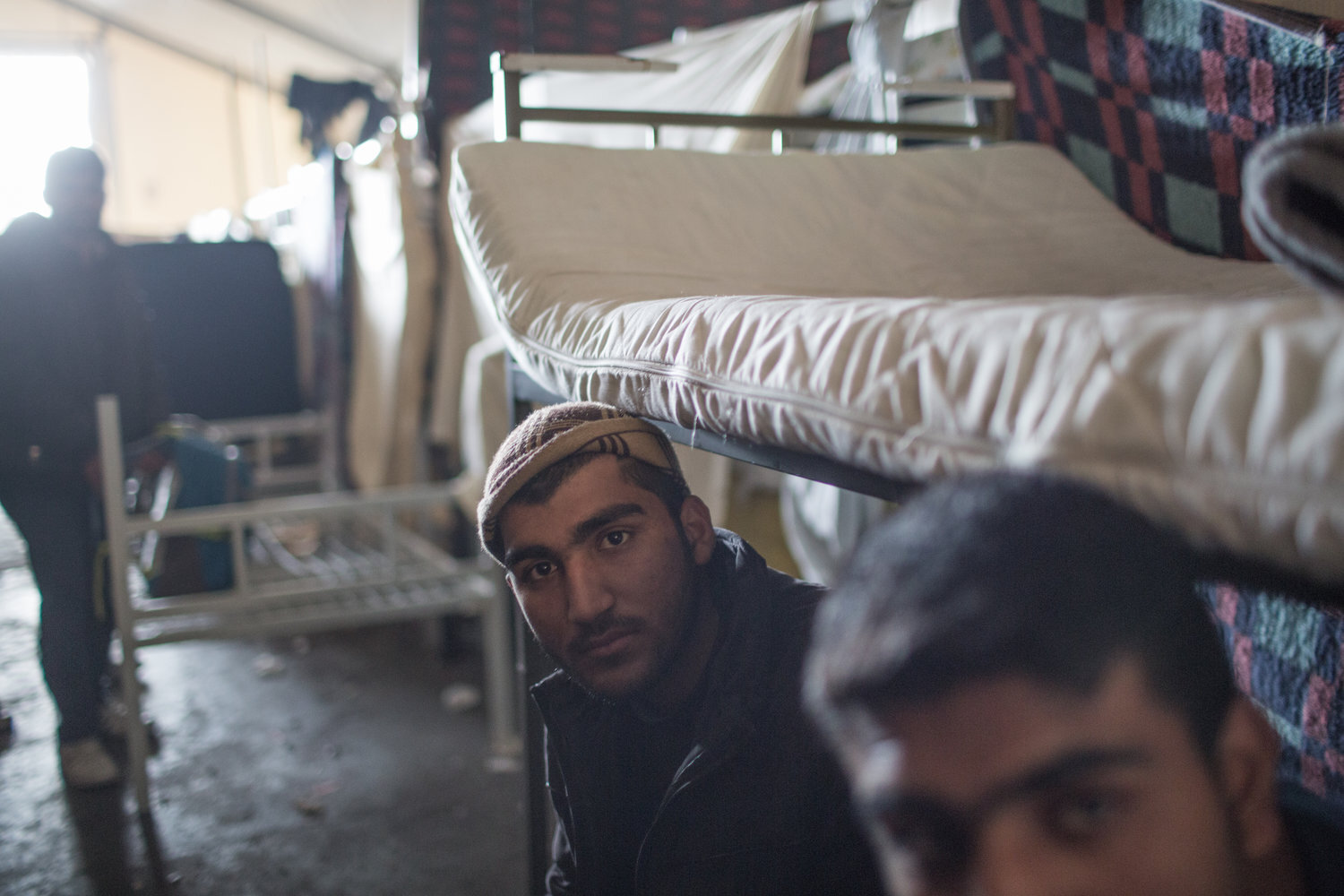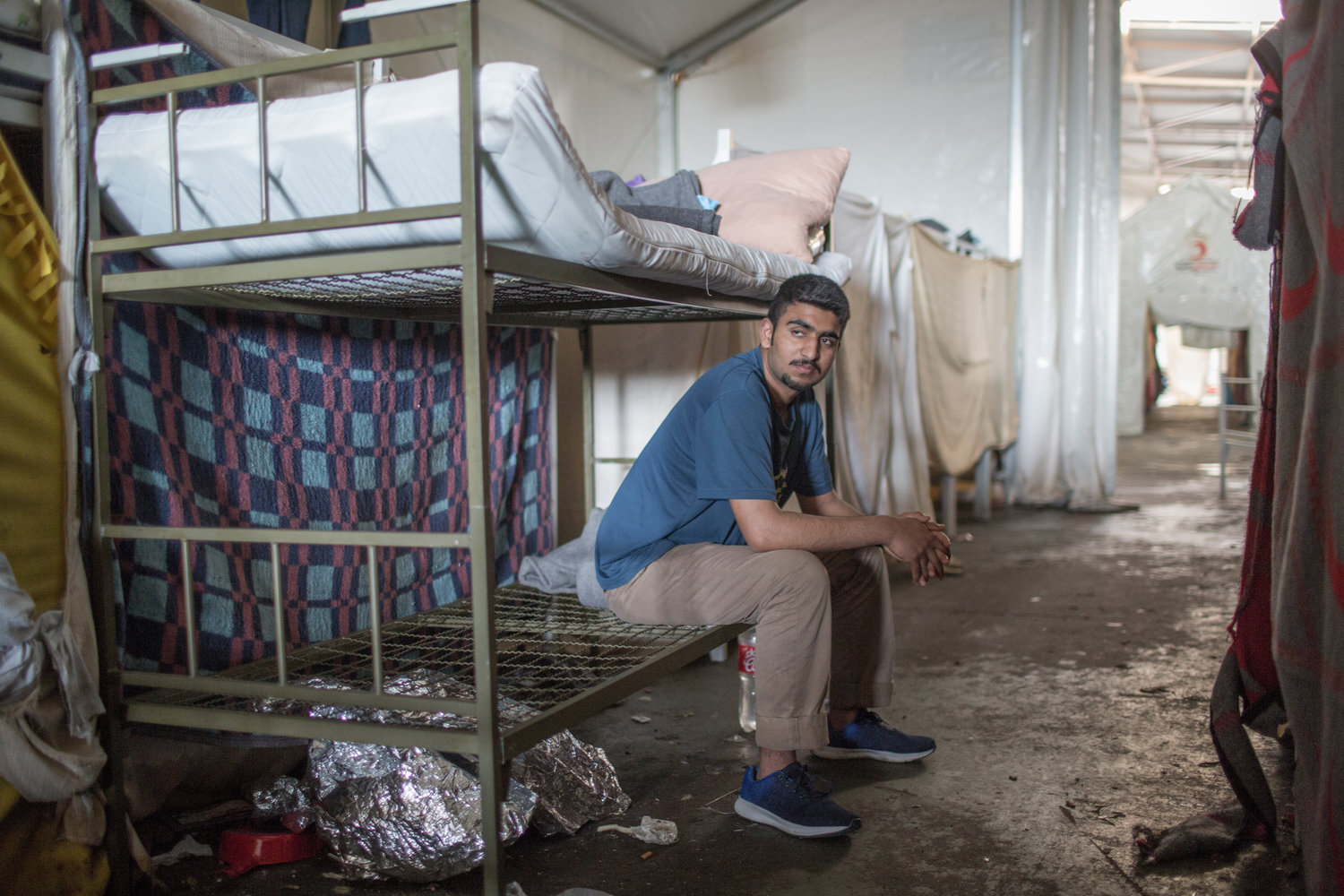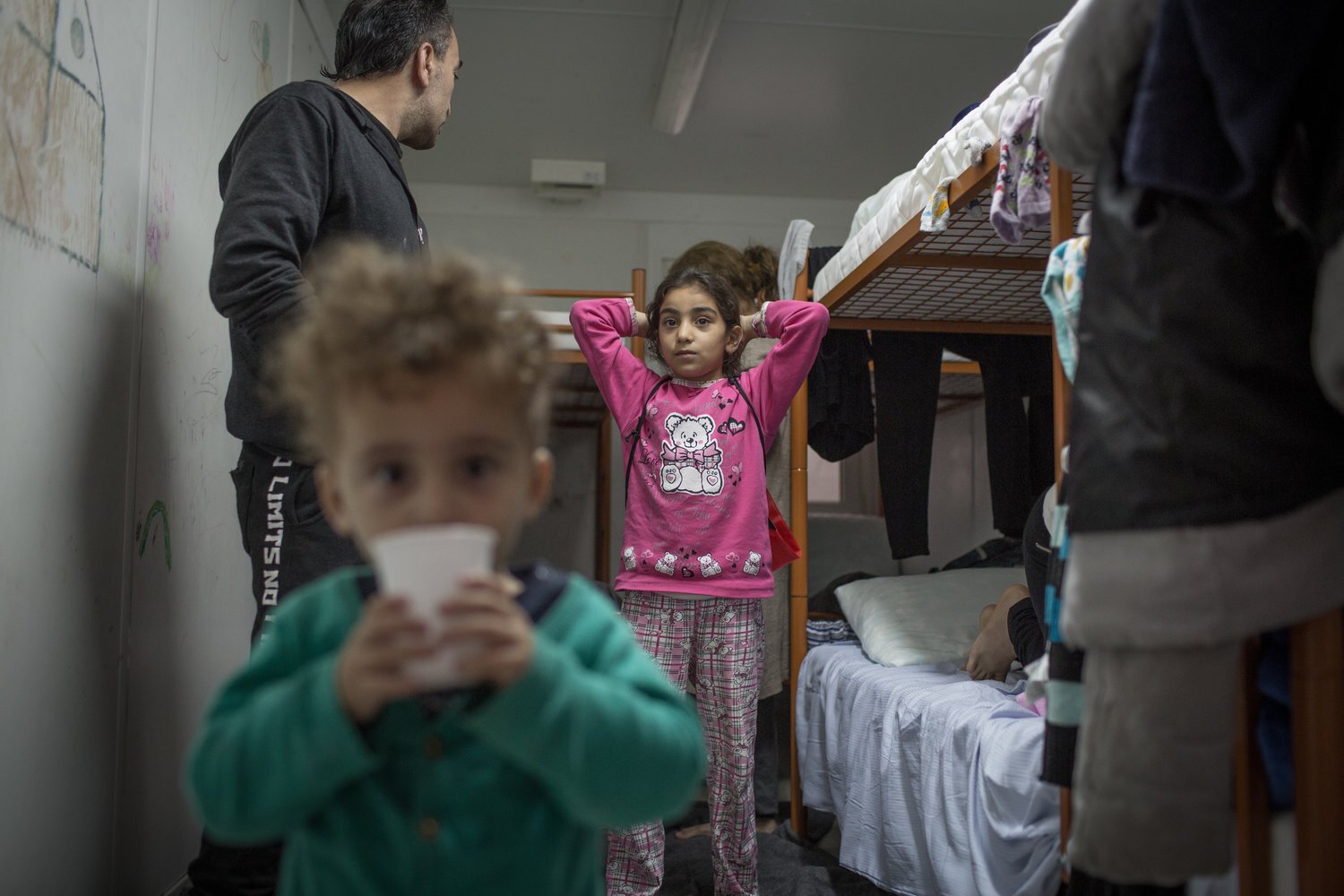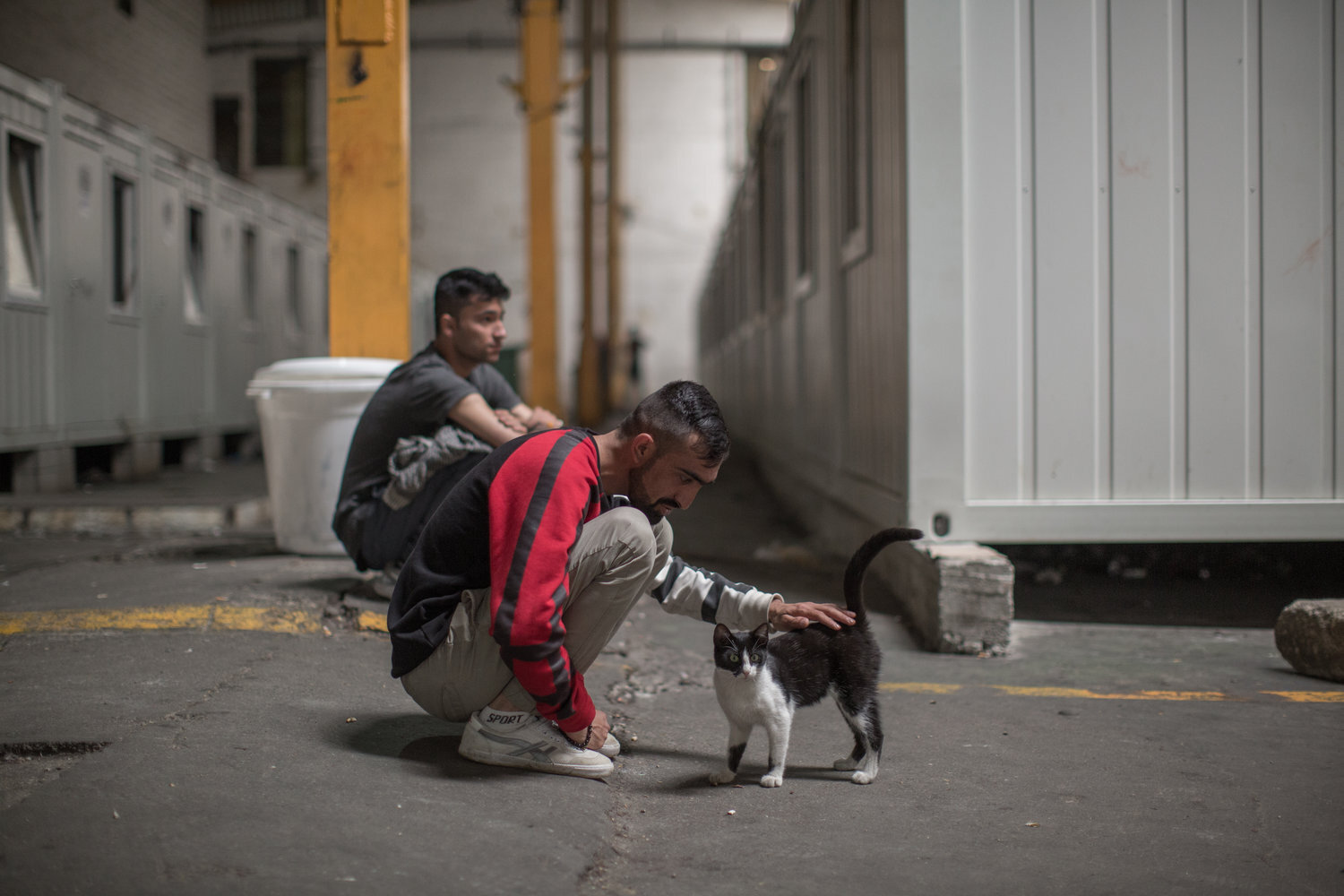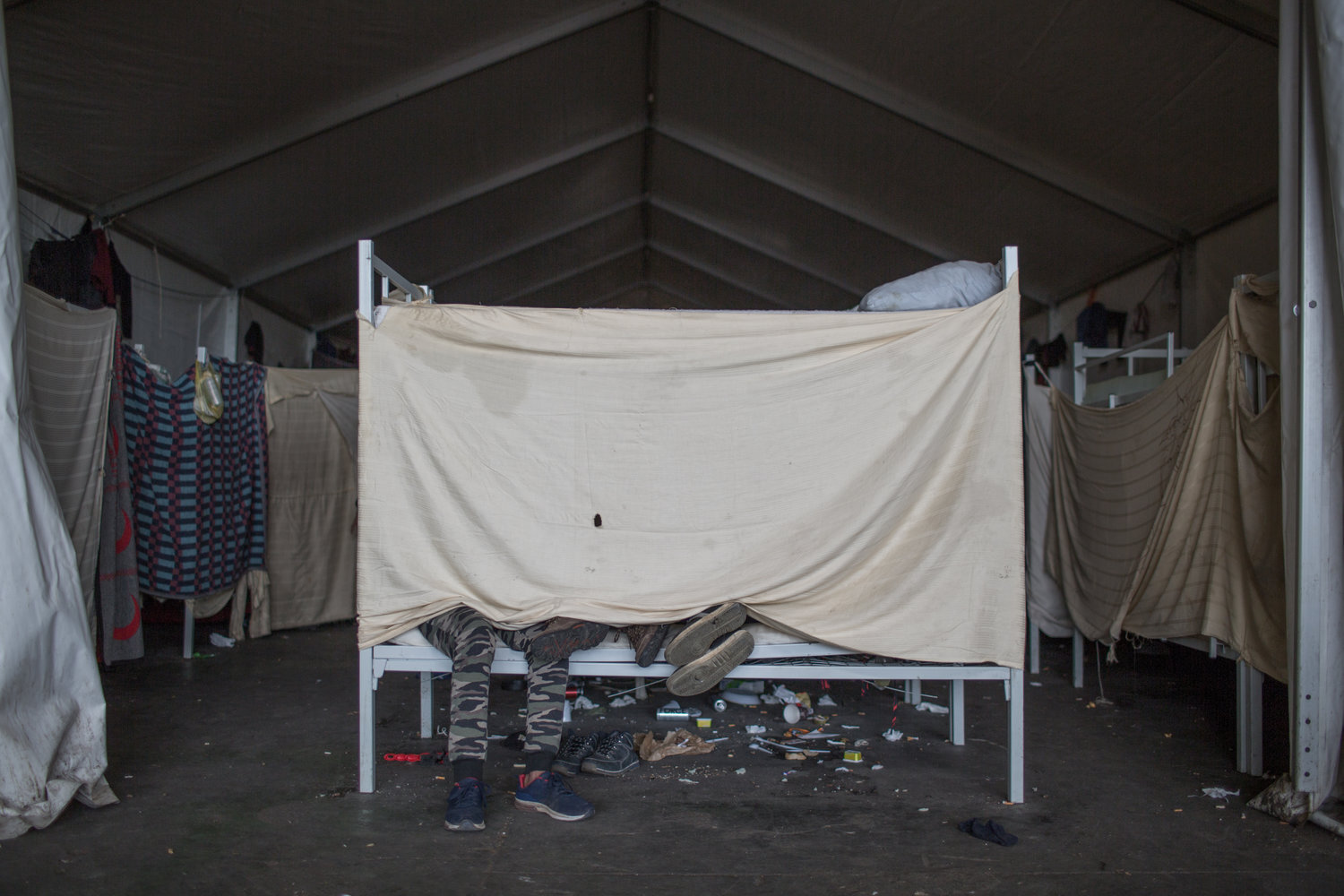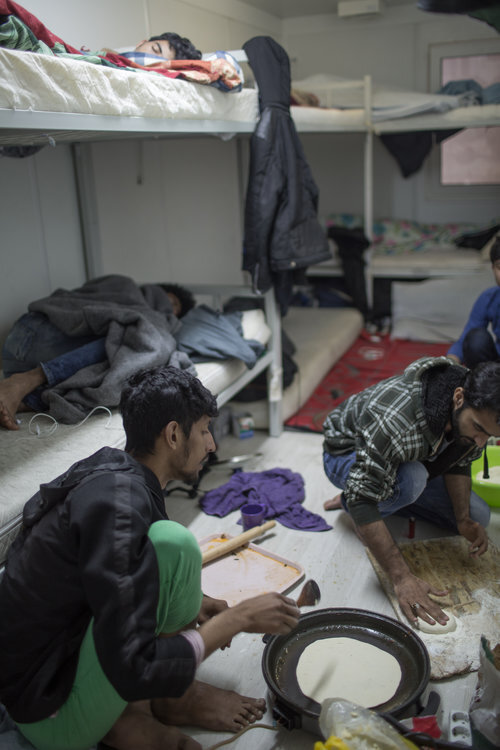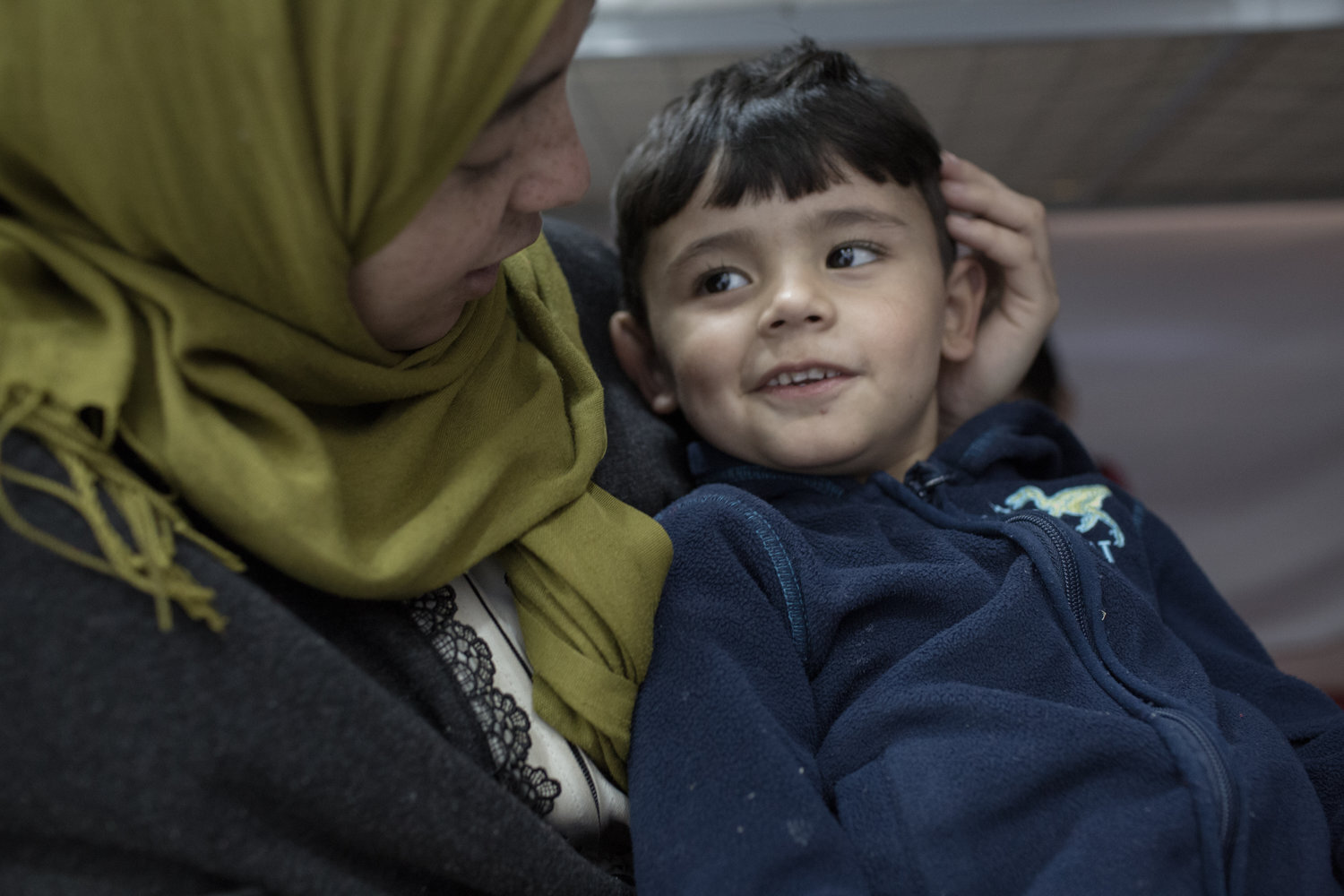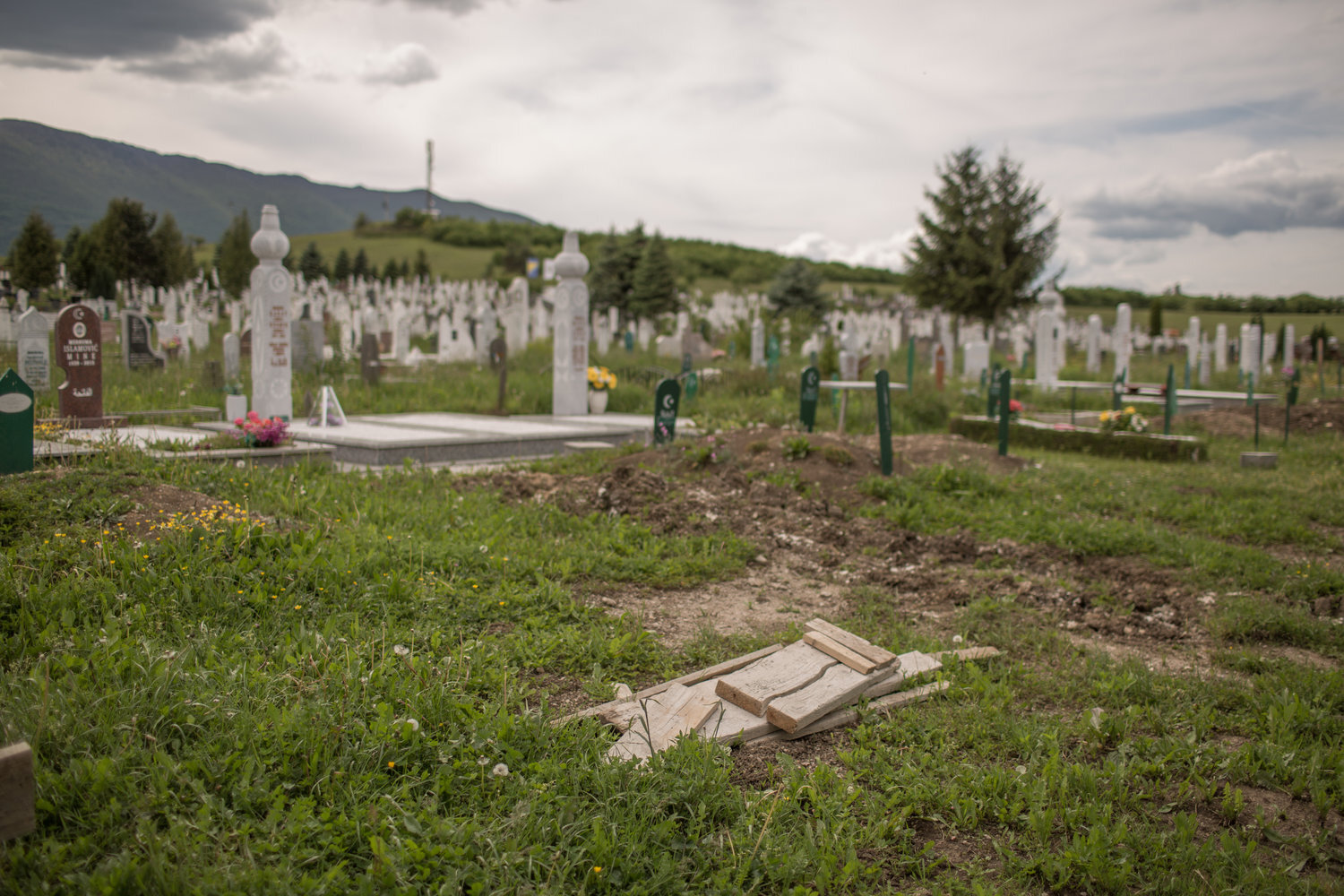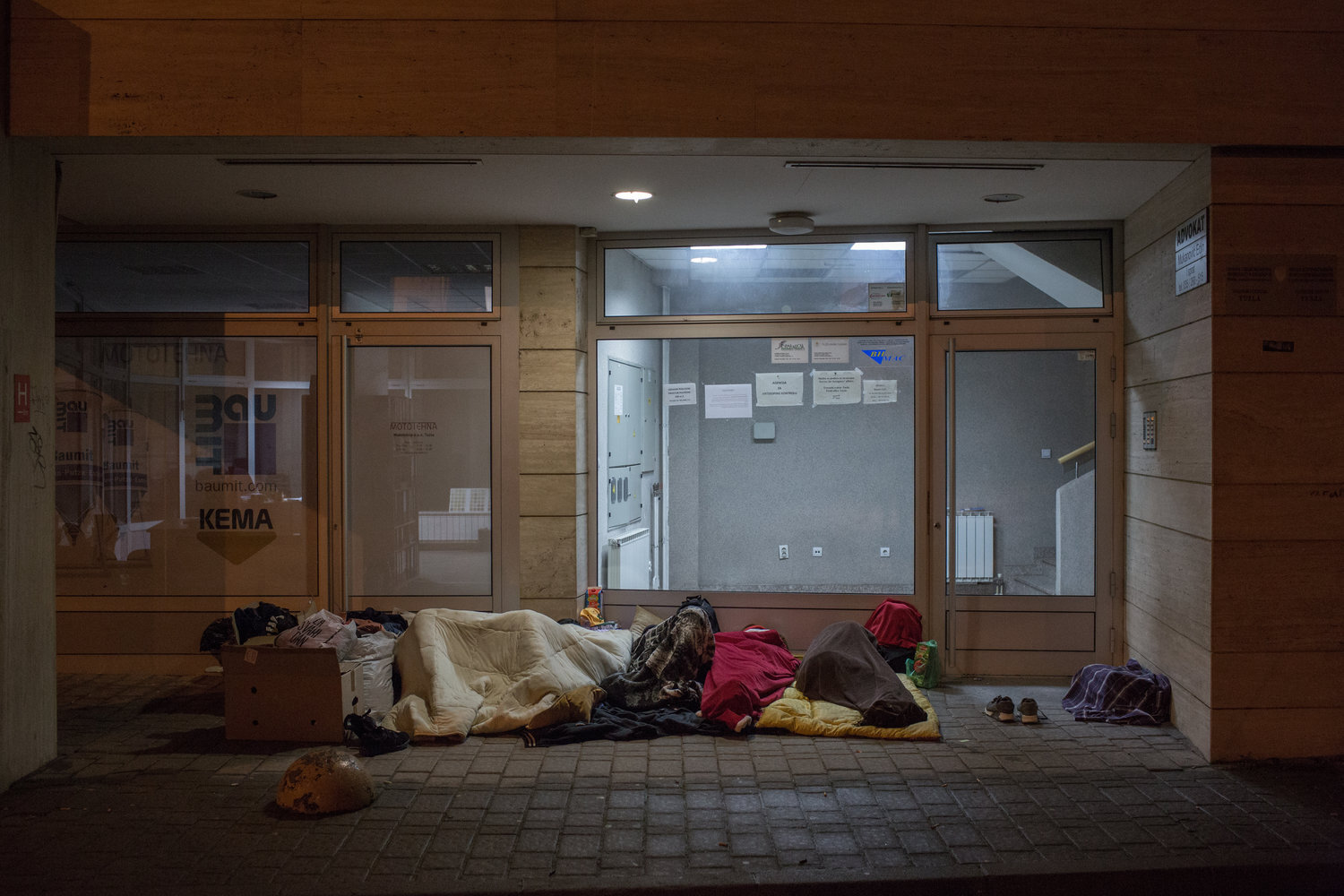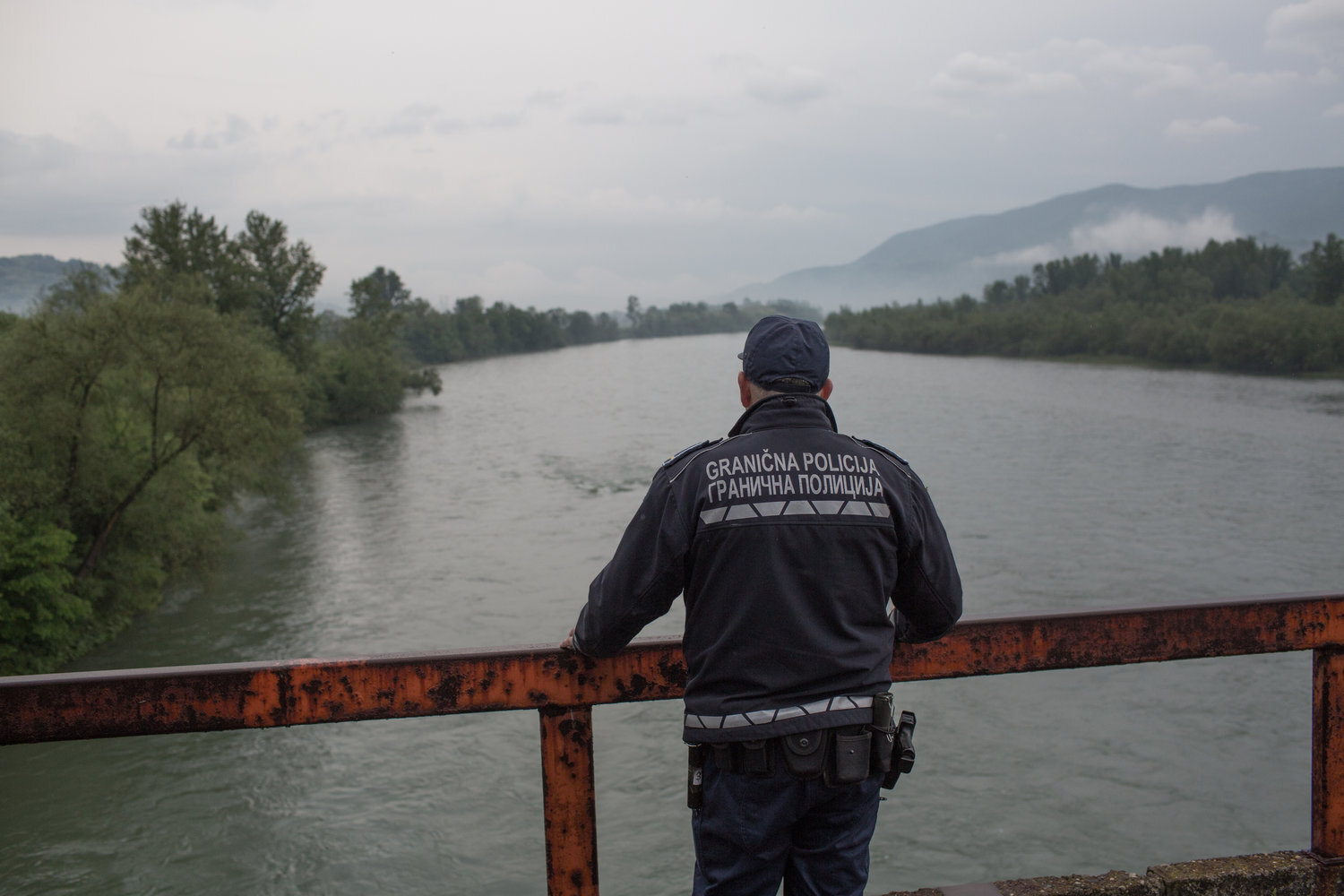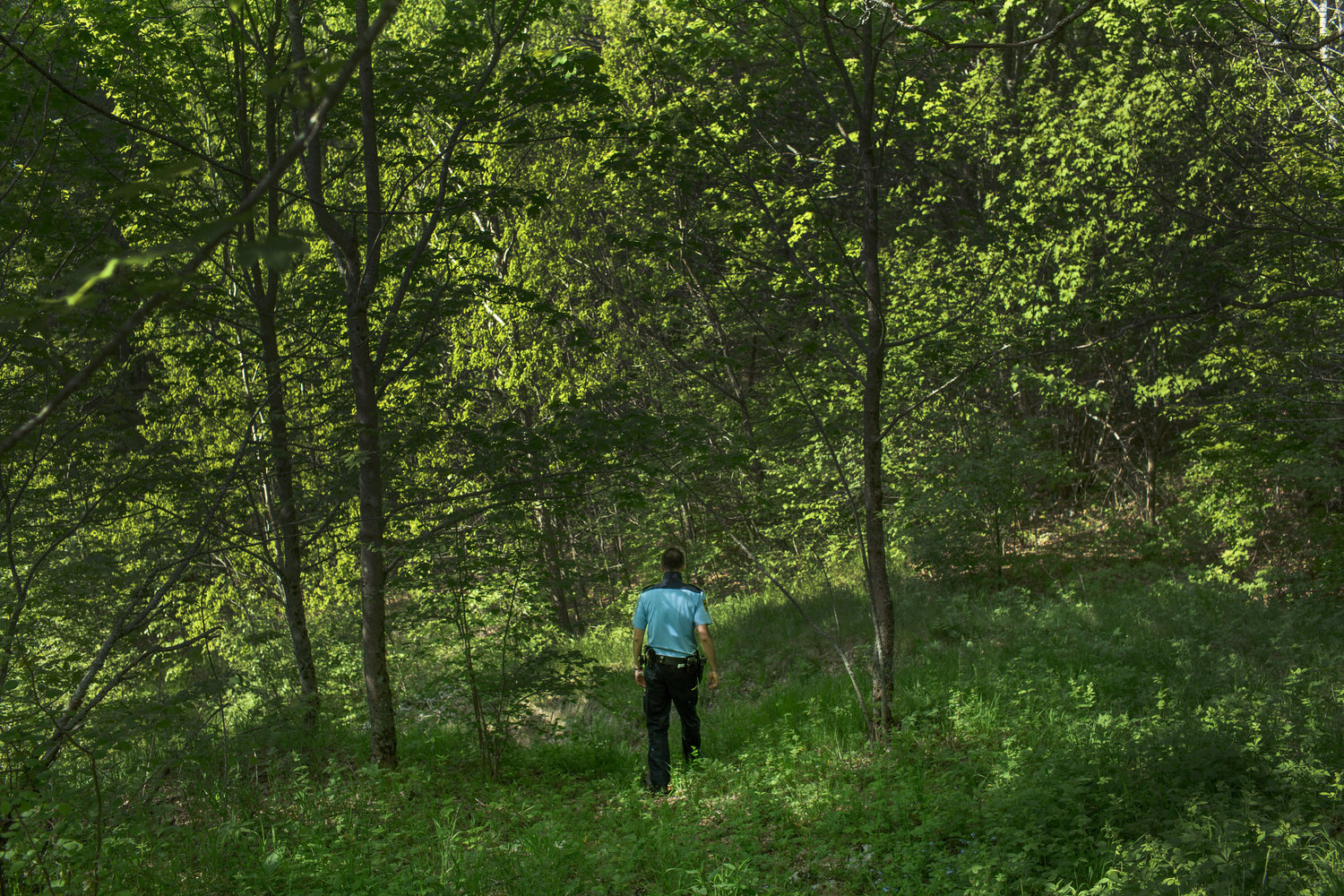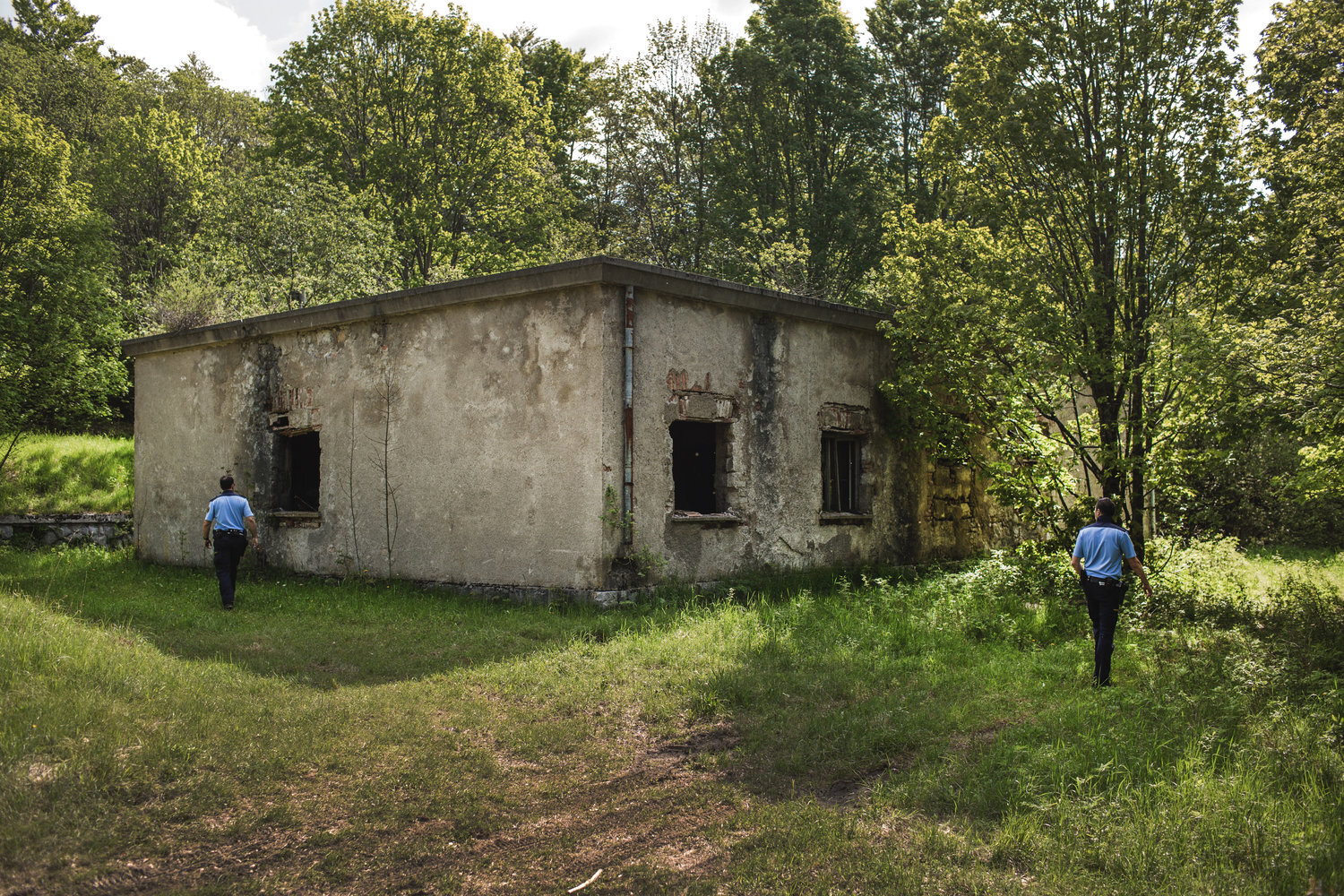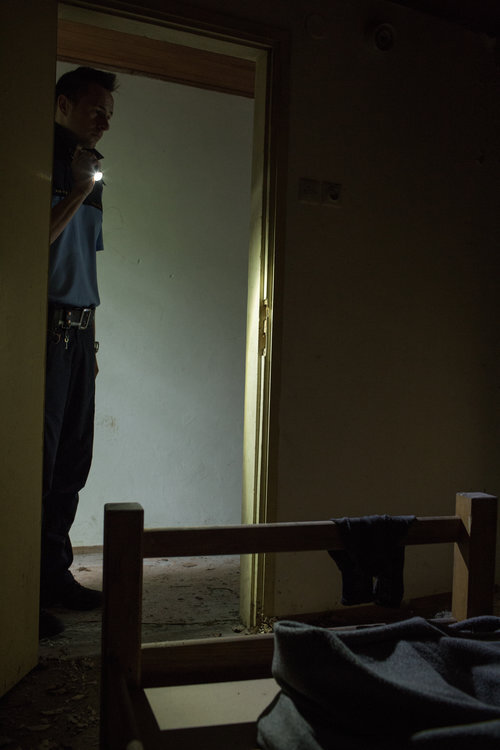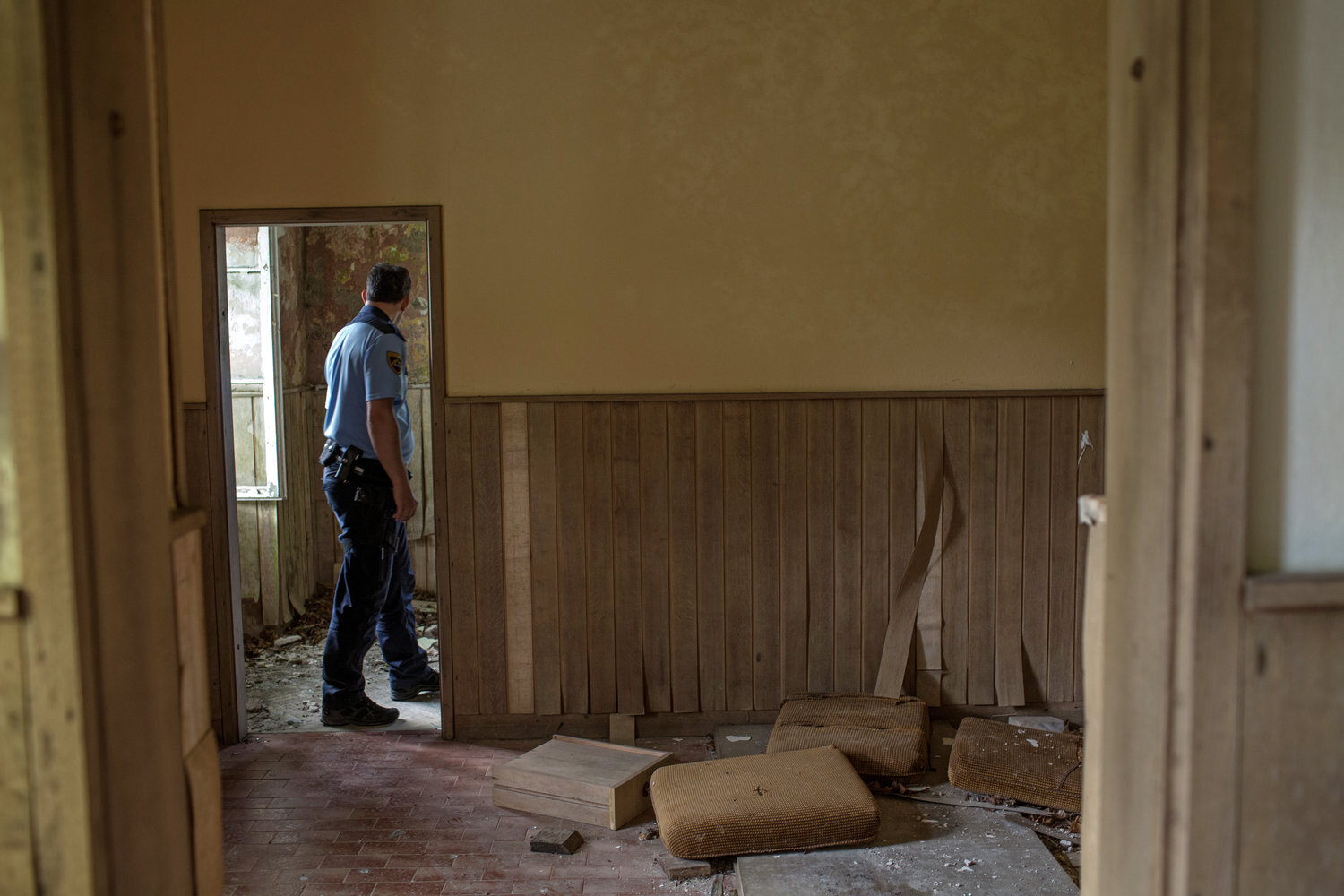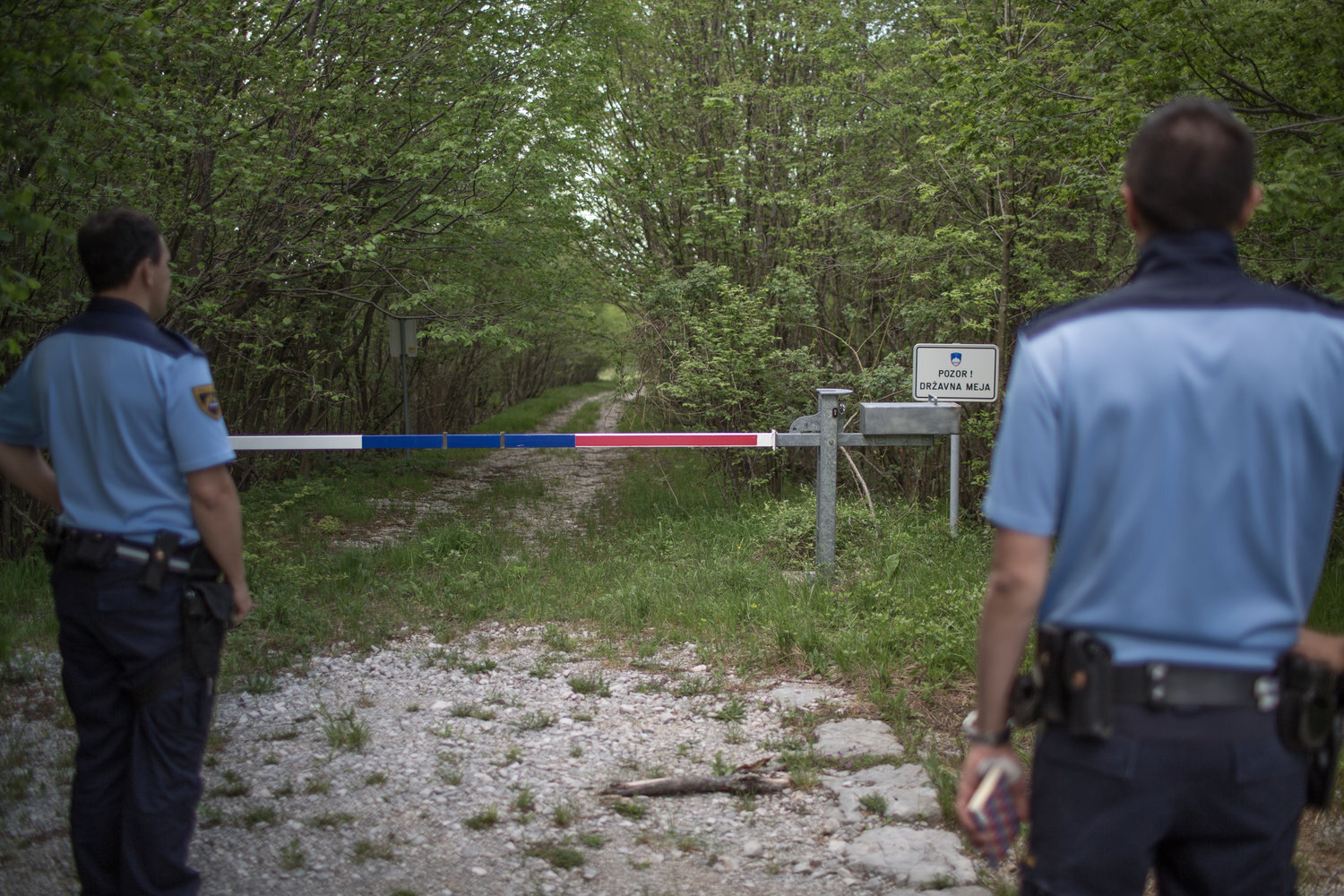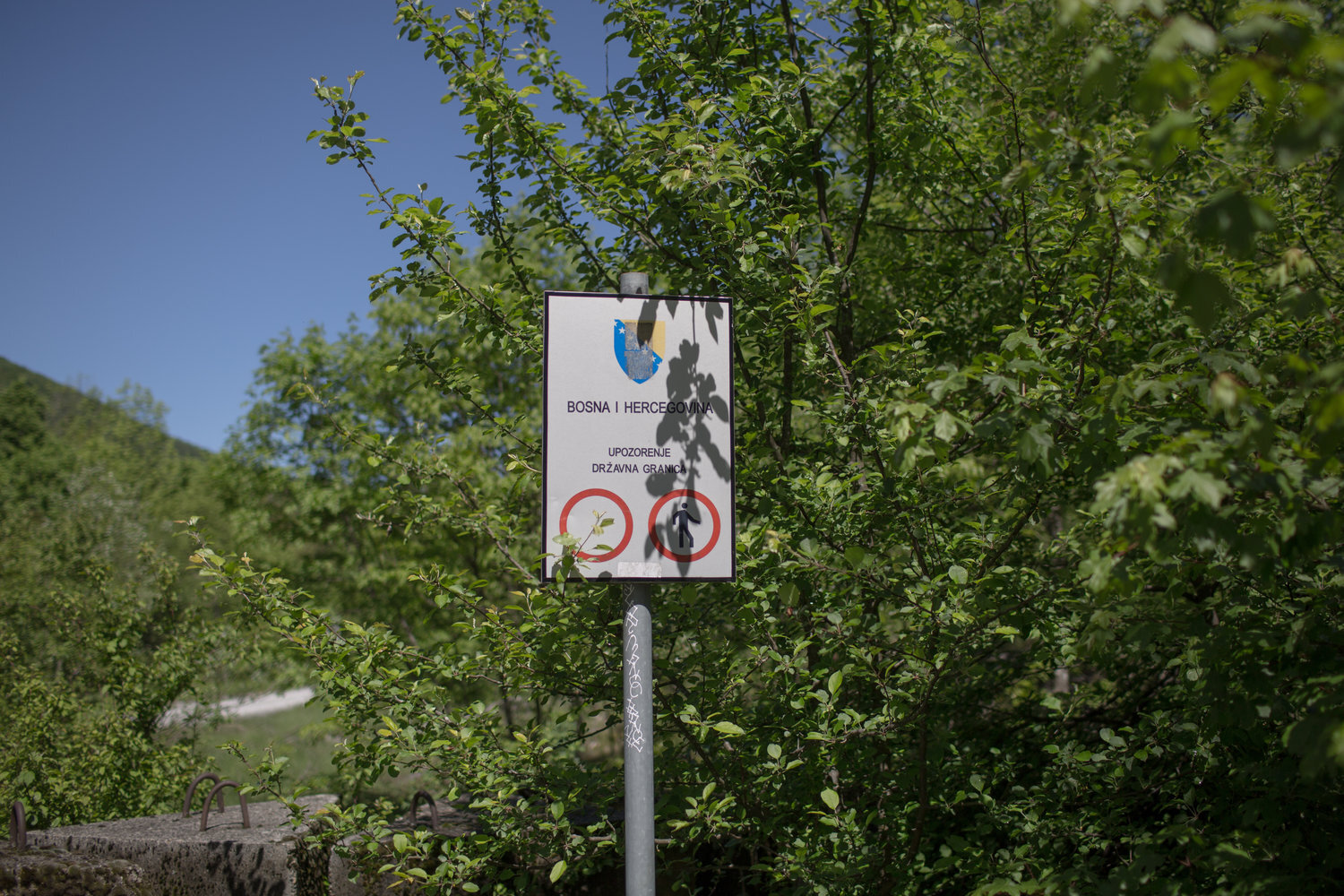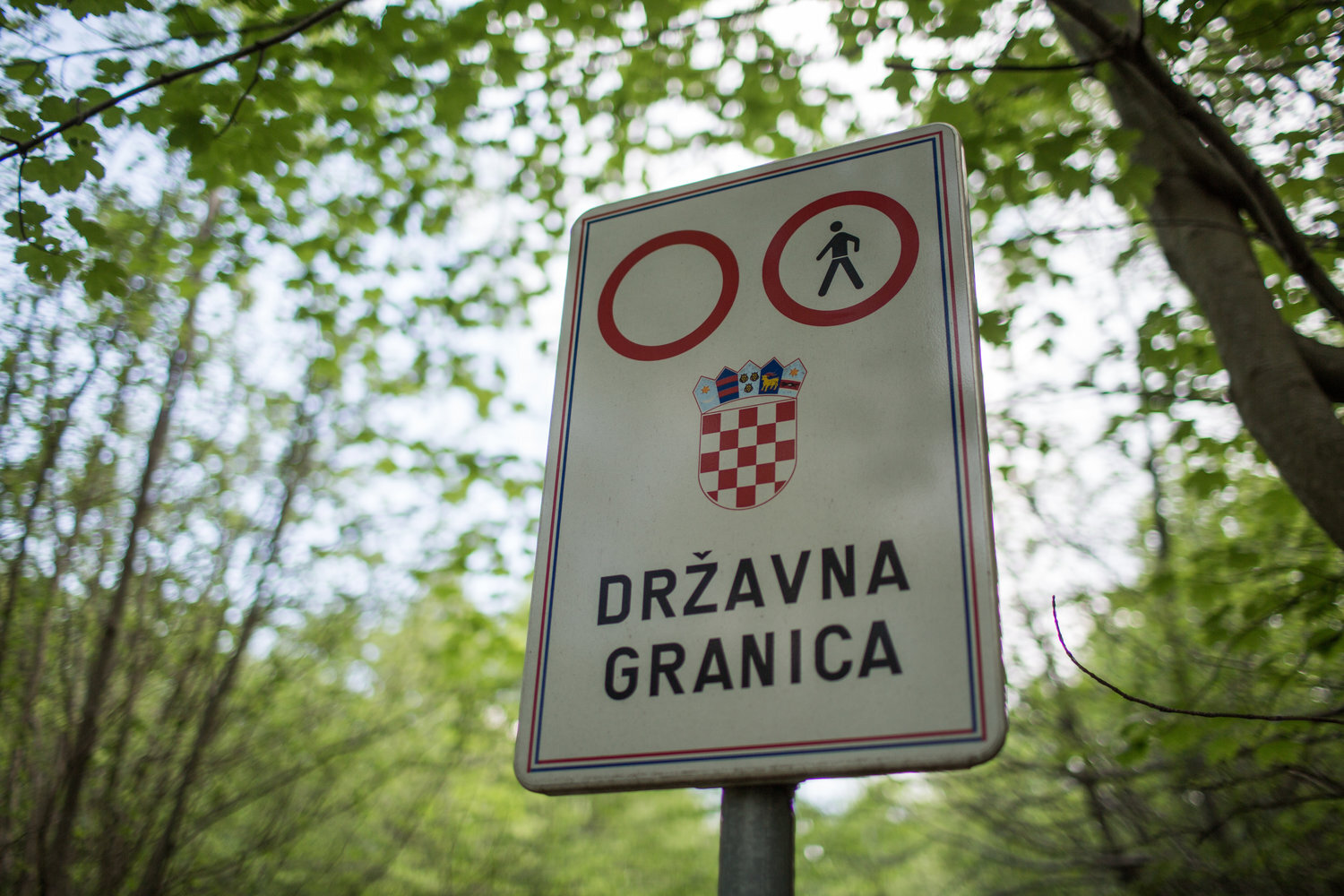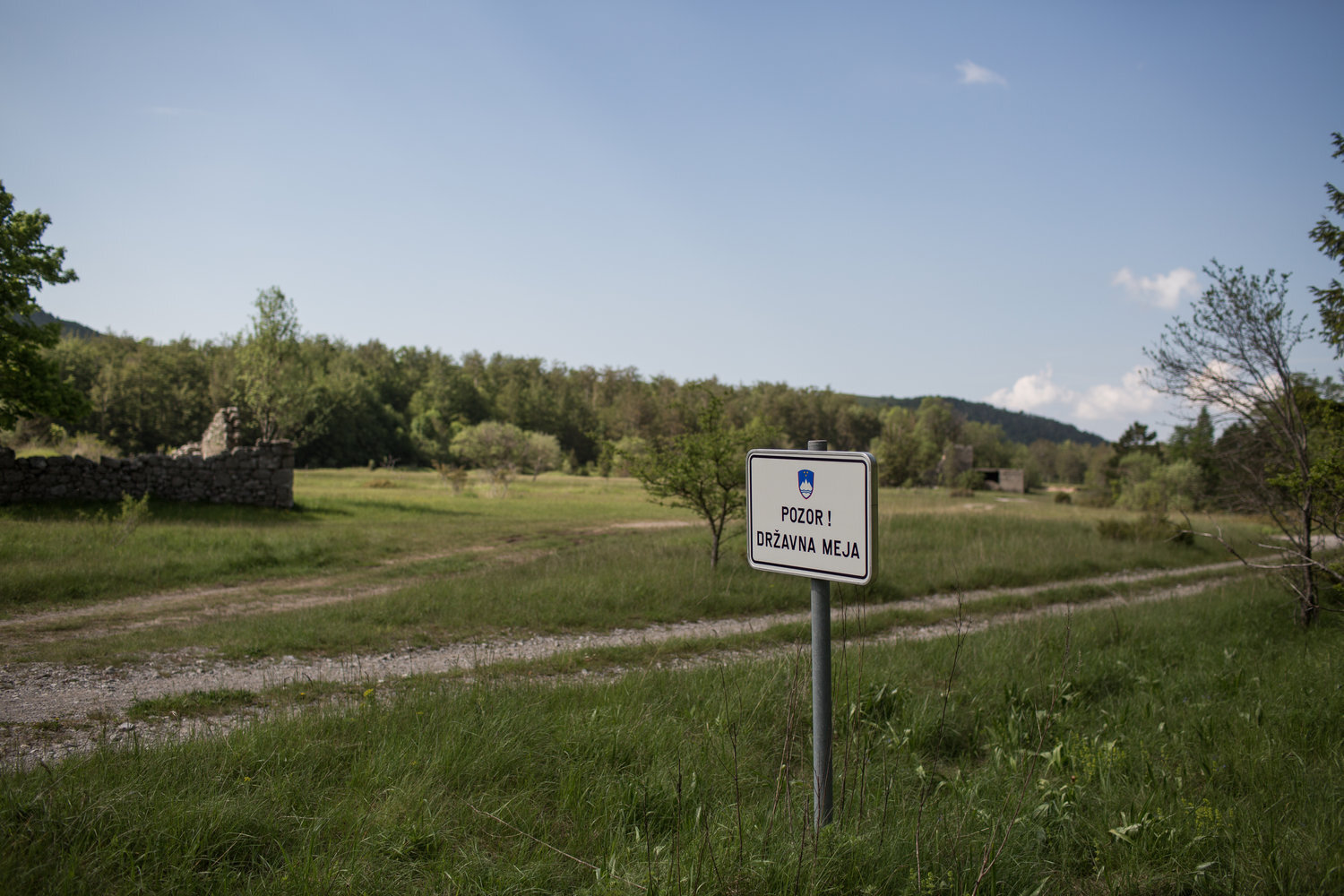The systematic infringement of human rights on the Balkan migrant route
Boštjan Videmšek, Mašenjka Bačić, Nerminka Emrić, Maja Čakarić, Klara Škrinjar
Photographs: Matej Povše
—
Despite the Ombudsmen’s warnings, refugees and migrants in Slovenia and Croatia still face difficulties when applying for asylum after they enter these two countries. They are being driven out of the European Union in droves, systematically and violently.
A migrant from Afghanistan in front of Bira in Bihać, one of the largest migrant centres in BiH.
Western Bosnia and Herzegovina is a bottleneck for migrants and refugees who are fleeing through the Balkans. During the past year, many of them are caught en route to Northern or Western Europe in Slovenia and then systematically handed over to Croatian authorities. In Croatia, they are often subjected to police violence. They finally end up in Bosnia and Herzegovina, where they are condemned to an interminable wait.
The Slovenian police deny migrants access to asylum and turn a deaf ear to their appeals. These are first-hand accounts of the migrants who we met along the Balkan route from Slovenia to Bosnia. Similar cases are also recorded by NGOs and are being investigated by the Ombudsman.
Such actions systematically contravene international conventions on human rights – within two EU member states.
Closed Balkan corridor
The situation today is very different from the one that came as a rude awakening to the public in the fall of 2015.
Memories of those events, during which, according to rough estimates, one million displaced people were on the move in the Balkans, are perhaps still freshly etched in some minds. Situation on the ground now, however, has changed dramatically.
The migration route towards Western and Northern Europe collapsed after the agreement between the European Union and the Republic of Turkey was concluded. Among other things, it provided for the return of refugees and migrants from Greece to Turkey. As stipulated in the agreement, its effects included the termination of mass migrations and an almost complete closure of the Balkan corridor in spring 2016. This meant that many migrants were left stranded in it.
During the following year, information emerged regarding the controversial return of displaced people in Slovenia and Croatia to the border with Bosnia, including reports of violence, confiscated and smashed phones, stolen money, thefts and damaged personal belongings.
Despite numerous testimonies and much evidence, the Slovenian and Croatian police outright deny the allegations of NGOs, media, migrants and refugees.
In the middle of July this year, the Croatian Ombudsman published an anonymous complaint from a group of Croatian policemen. In it, they admitted that according to their superiors’ instructions, they have to return migrants to Bosnia. Many of their colleagues used violence while doing this, took away migrants’ belongings etc.... “If we stood up to this, we would get laid off and then how we are supposed to support our families?” wrote disgruntled police officers.
A Syrian family from Hama who made it all the way to Slovenia, but was later returned to Croatia and Bosnia and Hercegovina. On the photo: in the search for a safe place to sleep in Velika Kladuša in BiH.
Many displaced people who we met along what is left of the Balkan route confirm such treatment.
Among them was a young Syrian family from Hama who made it all the way to Slovenia this spring. “As soon as we crossed the border, we bumped into Slovenian policemen. We tried to apply for asylum but they said that this wasn’t possible; that there ‘is no asylum in Slovenia.’ They returned us to Croatia where they took our phones. They treated us like savages even though we were travelling with kids. They threw us into a van and took us somewhere near the Bosnian border.”
From there, they went on foot in pouring rain and winter-like cold to Velika Kladuša, a town in north-west Bosnia and Herzegovina, which is currently one of the hotspots on the Balkan migrant route. The Bosnian Ombudsman estimates that at least 60,000 migrants will enter the country this year, but local authorities warn that the country is ill-prepared for them.
In Velika Kladuša, innkeeper Asim Latić-Latan let the drenched and exhausted Syrian family into the dining room of a former pizzeria, now converted into a makeshift soup kitchen. He has been serving refugees and migrants for a year and a half. His guests are fleeing from war, totalitarian regimes, poverty, violence and climate change, and he serves them dinner. Every day, he prepares as many as 800 evening meals for them.
Innkeeper Asim Latić-Latan every day prepares as many as 800 meals for migrants in the dining room of a former pizzeria in Velika Kladuša in BiH.
After arriving, the family ate dinner, their first real meal in a week, the father of two small children told us. He only gave us his initial, A. He was the only refugee who did not wish to reveal his full name among those whose testimonies are published below. He said he feared that the regime in his homeland, where his parents, brothers and sisters remained, would take revenge on his family.
A. headed from Syria towards Europe with his family, brother-in-law and his partner in the hope of asking for international protection when he arrived. He did not expect any complications as he was coming from a war zone and was travelling with children. He was wrong. His family joined the ranks of a mounting number of people who were stripped of their right to asylum before they even applied for it.
Fast-track refoulement
Starting in last spring, Slovenian police have denied many refugees and migrants the right to asylum and handed them over to Croatia. This practice of precluding the filing of asylum applications and pushing back refugees and migrants began at the end of May 2018.
At that time, a now former Director General of the Slovenian police, Simon Velički, issued instructions to policemen which said that people who are caught crossing the border by mixed Slovenian-Croatian patrols “should be handed over to Croatian police to be handled by them.”
Data published by the police on its own website confirms the changes in the treatment of migrants, and also possible irregularities in the procedures used for handling people who enter Slovenian territory with the purpose of applying for international protection.
The statistics on refugee refoulement rose dramatically from last year when, according to data from a report by the Slovenian police, as many as 4,653 people were deported to Croatia, which is 11 times more people compared to the previous three-year average since 2015, when the Balkan migration route was mapped out.
Migrant route through Balkan.
Slovenian and Croatian police deny entry to displaced people on the grounds of a bilateral agreement, which the two countries signed in 2006. This agreement provides for the return of migrants according to a summary procedure.
“It’s appalling that two EU member states simply get rid of some asylum seekers by using a summary procedure to bounce and return them into a third country,” said Amnesty International in the statement.
Due to allegations against the police regarding violations of the right of access to international protection, the Ombudsman’s office, as an autonomous and independent agency, reviewed the work of police.
Based on the findings of a report in February this year, the Ombudsman suggested to the Ministry of Internal Affairs that the police should take “all necessary measures” to ensure full respect for human rights, unhindered access to international protection and accurate documentation of procedures with foreigners.
A Slovenian police officer at the Slovenian-Croatian border.
If the Slovenian police hand over a foreigner who is caught by a Slovenian-Croatian patrol in Slovenian territory to Croatian security authorities, even though he has expressed an intention to apply for asylum, this, according to the Ombudsman, infringes on laws of international protection.
Among other things, it highlighted the lack of (serious) consideration of the personal circumstances of each individual. From police documents, it was not clear whether a detained person stated his or her intention to claim asylum or whether he or she stated such an intention but was possibly ignored. Such inconsistencies could mean that the police denied some people asylum procedures.
The Ministry of the Interior assured the Ombudsman that anyone can be informed of their rights in police facilities; brochures are available in various languages. Such provision of information is, according to the Ombudsman, undoubtedly useful, but should be accessible in places where people can leaf through the brochure’s contents.
The Ombudsman warns that an asylum seeker should be granted the possibility to apply for international protection and obtain it in line with the provisions of the Convention relating to the Status of Refugees, i.e. the Geneva Convention.
“The negligible number of cases of expressed intention to apply for asylum actually recorded at Črnomelj police station reflects the seriousness of the allegation that some police procedures could be irregular, including collective expulsions which are prohibited in compliance with the Convention for the Protection of Human Rights and Fundamental Freedoms,” explained Nataša Kuzmič from the Ombudsman’s office.
In its report from April this year, the civil society initiative Info Kolpa found that “the practice of violating the legislation by denying the right to asylum” became systematic last June. It states, among others things, that this practice spread from Črnomelj station to other police stations in the southern border region, such as Metlika, Ilirska Bistrica, and Dragonja.
Last June, soon after the above-mentioned instructions were issued, the share of people stating their intention to apply for asylum at the Črnomelj police station decreased by 95 per cent in only one month – from 98 to 3 percent.
We asked Slovenian police for updated data on asylum seekers for 2019 (by individual border police stations), but received none. They explained that gathering the data would be a “disproportionate administrative burden” on them.
Refusals
Statistical report on illegal migration, however, confirms that “the number of foreigners handed over rose considerably due to a strengthened collaboration with Croatian security authorities. The increase was noticed especially in the second half of 2018.”
That year, numbers have hit an all-time high. The number of all persons who were returned by the Slovenian police to the authorities of other countries rose by as much as 406 percent in 2018, compared to 2017. There was also a spike in the number of people returned to the Croatian border – a staggering 507 percent.
The publicly available data of the police also shows that the number of filed asylum applications in the first half of 2019 was similar as in the same period last year, but that the number of irregular national border crossings increased by as much as 47 per cent.
The number of refugees and migrants who the Slovenian authorities returned to neighbouring countries under the guise of various bilateral agreements rose even more – by 216 per cent. In the same period last year (from January to June), the authorities deported 1,117 people, whereas this year they refouled as much as 3,534 people. By far the most (98 per cent) were returned to the Croatian border.
Migrants on their way across the mountains at the border between Croatia and Bosnia and Hercegovina with the town of Bihać in the background. Migrants usually start their journeys during the night for a reason: to not be seen by police and other residents. They walk off the beaten tracks, across the woods and far from towns.
Urša Regvar from the Legal-Informational Centre for NGOs (Centre PIC) stated that some asylum seekers still claim to have been denied access to asylum procedures, “which confirms our observations and shows that individuals at the border are still being denied access to protection.”
“We have already provided answers to such generalisations and unfounded accusations in the past, as well as explained that we verified each and every one of the cases presented to us. So far none of these allegations have been confirmed,” stated the police.
For some time, journalists, activists and NGOs have been sounding the alarm that the police procedures at the border are non-transparent, carried out systematically and en masse. Last year these suspicions have reached the Slovenian Ombudsman and Information Commissioner.
Suspicions of illegal police procedures and possible violations of human rights are also being investigated by the Specialised State Prosecutor’s Office. The investigation is ongoing.
A crucial document was appended to the report of Info Kolpa which states that, last May, the management of the Slovenian police gave orders to all police stations about how to treat migrants and asylum seekers at the border.
Until recently, the document was confidential. But the police had to disclose it as Amnesty International required access to public information under the freedom of information law.
“The public, however, is not familiar with the entire content of these instructions, because the police is contesting the disclosure in court despite the decision of the Information Commissioner that it involves public information,” Info Kolpa added. The procedure is pending.
Despite the warnings of national Ombudsmen, that the situation needs to be improved, the systematic and collective expulsion of asylum seekers continued this year. We gathered testimonies that prove this.
Transport into a bureaucratic triangle
Not far away from Plitvice National Park, one of the most important Croatian tourist sites, lays the town of Korenica. It looks slightly forlorn, its buildings rather dilapidated.
Although it is just a stone’s throw away from a national treasure, it is off the beaten tourist path. According to Croatian NGOs, the Korenica police station compound has become a “bureaucratic triangle” or “temporary accommodation centre” for a different type of visitors.
Migrants who are captured during border crossings are first taken to this faraway police station and then onward to the green border from where they are expelled to Serbia or BiH.
Police station Korenica and a garage behind it. Migrants are detained and mistreated there.
“It’s true that they bring migrants here,” confirmed an inhabitant of Korenica. As to why, how and how many – she did not know.
However, the report on illegal push-backs and border violence published in April of this year by the NGOs that collaborate in the Border Violence Monitoring initiative contains more testimonies about this particular police station or, to be precise, garage next to it. According to the information published by the H-alter.org portal, people are detained and mistreated there, and then returned to BiH.
Croatian police categorically denies it is carrying out push-backs. Not only refugees’ testimonies but also a series of photographs and videos nevertheless prove the opposite. The President of Croatia herself – Kolinda Grabar Kitarović – recently asserted that “a touch of force” is necessary when pushing back migrants.
The irregularities in police treatment are reflected also in official statistics, or rather in their incongruities. The civil initiative Dobrodošli (Welcome) and two NGOs, the Center za mirovne študije (The Center for Peace Studies, CMS) and Are You Syrious, discovered inconsistencies in official data.
In 2018, 8,207 people crossed the Croatian border irregularly, 71 per cent more than in the previous year. The rise in such border crossings was most obvious close to the border with Slovenia and amounted to as much as a 158 percent increase. In the vicinity of the border with BiH, Croatian police noted an 88 percent increase in crossings, whereas irregular crossings in the rest of the country increased by 55 per cent.
Among those 8,207, 1,438 were returned to third countries, 1,068 applied for asylum and 536 were detained. This means that there is only data about a total of 3,042 people who were detained by the Croatian police while they attempted to cross the border.
“Where are the remaining 5,165 people and how did police treat them?” wondered Julija Kranjec of CMS. In its report, CMS assumed that these people were illegally refused entry in Croatia. It speculated that the police did not register all of the people they capture.
According to CMS, there are no official statistics on expulsions of refugees from Croatia. In light of data collected by international organisations, they conclude, however, that Croatian police have illegally pushed at least 10,000 people back to neighbouring countries.
“I constantly repeat the question: where are these people?” says Maja Kević from the Croatian Ombudsman’s office that receives complaints about illegal returns of migrants to Serbia and BiH. The majority of complaints in the last annual report of the Ombudsman refer to police procedures against migrants who were apprehended during national border crossings or immediately after them.
The Ombudsman’s office also discovered internal rules which allow the Croatian police to carry out the push-backs.
Mnogi migranti prijavljuju da je policija do njih nasilna.
According to the statements of the Ombudsman, these rules are supposedly based on an oral order from the end of 2016 and document from 15 February 2018.
According to instructions from the then Director General of Police, Marko Srdarević, policemen must send migrants found deep in the Croatian territory to a police station nearest to where they crossed the border and not to the station closest to where they were apprehended – as stipulated by Croatian law.
In addition, according to Kević, the Ombudsman’s investigations revealed the existence of a form that is presented to migrants “which, among other things, states that migrants agree to be returned, do not need a translator, can communicate also with the help of Google Translator and the like.”
This flies in the face of Croatian law. Refugees should be given the option to apply for asylum if they wish to do so. They should be treated individually in order to find out why they entered the country at all, says Kević.
The form they have to sign is actually a decision about their departure under which they have to leave the country within seven days. In order to cross the border, they would need to posses valid documents which the majority of migrants does not have and cannot obtain.
“Therefore we think, and also state it in [our] report, that they take them to these outlying police stations in order to get them across the green border,” continued Kević. She believes that this constitutes violations of human rights, which, considering the large numbers of returns, are being committed en masse.
The Croatian Ministry of the Interior – just like the Slovenian one – consistently denies illegal conduct of the border policemen, despite mounting evidence to the contrary.
This May, a Swiss television channel published footage of a policeman pushing migrants over the green border into BiH. When questioned about it, Croatian interior minister, Davor Božinović, said: “This is another futile attempt at growing accusations against the Croatian police which abides by national and European laws.”
Bosnian camps
Migrants and refugees caught by the Slovenian or Croatian police upon crossing the border end their journey in Bosnia and Herzegovina (BiH) for an indefinite period of time. Bira, a former factory of air-conditioning devices located in the north-west town of Bihać, is one of the largest migrant centres in the country.
Every migrant that lives there has attempted to cross the border with Croatia illegally, at least once, and then to continue their journey towards Slovenia. Some of them were returned; others succeeded in their attempt, or ended up in Serbia.
According to data from Bihać’s communication office, around 11,000 migrants have arrived in Bihać between last April and this June, whereas the Ministry of the Interior of Una-Sana Canton counted 17,000 of them. These were only how many they actually registered. No one can explain this discrepancy since both authorities say they are registering them correctly.
Migrants often sleep outdoors due to lack of the place in the migrant centres.
Various displaced people converge on the streets of Bihać: from Syria, Pakistan, Libya, Afghanistan, Algeria, Morocco, Tunisia, Palestine, Iraq, Iran, and other Middle Eastern and African countries. Many of them sleep outdoors. Some of them find shelter in abandoned buildings, of which there are plenty in Bosnia.
For a long time, no one took care of the migrants without a place to stay in BiH. In July of last year, the inter-governmental institution International Organization for Migration (IOM) took over the care of refugees and migrants in all reception centres across BiH. These centres, however, are often full, thus many migrants are left out on the streets without a roof over their head.
During our visit this spring, the reception desk in front of Bira centre was buzzing with around 500 people milling around. When we talked to them, they asked us for help and told us that no one in Bira centre wants to help them. They claimed that they were not given food or water.
Melisa Kljuca, the IOM representative who manages the Bira centre, assured us that everyone is getting regular meals but that the centre is overcrowded.
Accommodation in the migrants center Bira in BiH.
We also witnessed how security officers from Bakrač, a private security company that protects Bira centre, used electric stun devices to force the migrants away from the entrance to the reception centre. The use of such devices is prohibited by Bosnian law.
We contacted a representative of the Bakrač security company but they were not willing to explain why they use them. Melisa Kljuca of IOM told us, however, that individual security guards had already been suspended and relocated due to the use of these batons.
That night many migrants were left outside, sleeping in a meadow close to Bira centre. Not far from Bihać, Bosnian authorities set up tents in a field previously used as a landfill. The police now send the migrants they find on city streets to this improvised camp, called Vučjak. Living there is worse than being in prison, they say.
Balkan route’s bottleneck
Migrants usually enter BiH at its eastern border, where there are no reception centres. Then they head to the country’s interior, towards Tuzla. As we witnessed on the ground, the brunt of the migrant crisis is borne by a handful of volunteers. They act on their own initiative and are occasionally aided by humanitarian organisations and a few of Tuzla’s inhabitants.
Among the most active is local Senad Pirić. He says they cope as best as they can and that they are already exhausted. Their supplies of food, sanitary material and other basic necessities are almost gone, but there are more and more migrants pouring in every month.
Displaced people enter the Federation of BiH or Republika Srpska from neighbouring Serbia across the Drina River. The government of Republika Srpska, one of two political entities of BiH, insists that it will not help migrants but that it can provide a humanitarian corridor. Hence, policemen direct everyone who enters Republika Srpska into the other entity, the Federation of BiH, and Tuzla.
The railway bridge across the river Drina near Karakaj, at the border between Bosnia and Hercegovina and Serbia.
Ondje svaki dan u kasnim večernjim satima prepješači više migranata. U pravilu dolaze u skupinama u kojima je i do trideset ljudi. Svi su mokri, gladni i prestravljeni. Skupe se ispred Terenskog centra za poslove sa strancima BiH, u parku ili na središnjoj autobusnoj postaji u gradu, odakle idu prema Tuzli.
“No location in Tuzla is suitable for living. Public toilets do not operate in the evening. There is also no provision of health services or any help from the responsible authorities,” explained Pirić.
The authorities are intentionally indifferent to this problem, claims this tireless volunteer, who offers help to refugees and migrants day and night. He says that BiH has no systemic solutions to deal with the migrant issue. “They are not allowed to enter the EU and here, where they are stranded, they are also not provided with anything,” said Pirić sadly. “They are stuck and can go neither backward nor forward.”
“By being unresponsive, the country blatantly infringes on basic human rights of refugees and migrants, while the EU encourages non-member states to use repressive methods,” said Nidžara Ahmetašević, a Bosnian activist and journalist who has been covering the migrant crisis since 2015.
Migrants sleeping in front of the registration centre in Tuzla, the first town they enter on their way from Serbia to Bosnia.
Denial and indifference
Following three months of intensive fieldwork and data analysis, we conclude that the practice of push-backs – denial of entry to refugees and migrants at the border without the possibility of applying for asylum – on the Balkan route continues unhindered in 2019, despite warnings of national Ombudsmen, NGOs, journalists and others.
Testimonies of numerous refugees and migrants stranded in BiH, particularly in Velika Kladuša and Bihać, confirm this. We verified their claims on the ground and also in comparison to official data. These testimonies are of key importance because they provide evidence of systematic mistreatment of migrants which contravenes international conventions on human rights and refugees.
The Refusal of entry is happening at the Slovenian-Croatian border. In addition to testimonies, this is seen also in the official data which is sometimes incomplete. For instance, it is impossible to know how many refugees and migrants Slovenian police pushed straight back to Croatia after they crossed the border, because many of them are not included in official data in Slovenia, and oftentimes neither in Croatia.
In Croatia, the local police – as also confirmed by the testimonies – employ brutal and cruel measures to return refugees to Bosnia and Herzegovina, where inhumane conditions prevail in the migrant centres under the auspices of the International Organization for Migration. Many must fend for themselves.
Slovenian police consistently denies violations of international conventions and asylum legislation. The same applies to the Croatian police, which flatly denies all allegations of violence.
In Bosnia and Herzegovina, or the bottleneck of what remains of the Balkan route, political representatives at the highest level practically do not bother with the migration issue. According to IOM’s data, there are currently 7,000 people on the run in Bosnia.
Photo Gallery
Photographs by Matej Povše
The project is supported by Journalismfund.eu. We ran it in cooperation with reporters and a photographer from Slovenia, Croatia and Bosnia and Hercegovina.














